Advancements in the Additive Manufacturing of Magnesium and Aluminum Alloys through Laser-Based Approach
Abstract
1. Introduction
2. Additive Manufacturing Approach: Magnesium-Based Alloys
2.1. Laser-Based Additive Manufacturing Approach
2.2. Investigation of Mg Alloy via Additive Manufacturing
2.2.1. Pure Mg Alloy
2.2.2. Mg-Al Alloy
2.2.3. Mg-RE Alloy
2.2.4. Mg-Zn Alloy
2.3. Mechanical Properties of Laser-Based Additive Manufacturing Approach
2.4. Electrochemical Durability of Mg-Based Alloy Prepared by Lased-Based Powder Fusion
2.5. Biocompatibility of Mg-Based Alloy Prepared by Lased-Based Powder Fusion
2.6. Challenges Inherited in Laser-Based Approach Relating to Mg-Based Material
3. Additive Manufacturing Approach: Aluminum and Its Alloys
3.1. Selective Laser Melting Approach Relating to Al Alloy
3.2. Properties Evaluation of Al Alloy Formed by SLM Technique of Additive Manufacturing
3.2.1. Nano-Hardness of Laser-Based Additively Manufactured Al Alloy
3.2.2. Micro-Hardness of Laser-Based Additively Manufactured Al Alloy
3.2.3. Tensile Characteristics of Laser-Based Additively Manufactured Al Alloy
3.2.4. Compressive Characteristics of Laser-Based Additively Manufactured Al Alloy
3.2.5. Fatigue Characteristics of Laser-Based Additively Manufactured Al Alloy
3.2.6. Fracture and Creep Characteristics of Laser-Based Additively Manufactured Al Alloy
3.2.7. Impact and Wear Resistance Laser-Based Additively Manufactured Al Alloy
3.3. Metallurgy of Laser-Based Additively Manufactured Al Alloy
3.3.1. Microstructure of Al Alloy Formed by SLM
3.3.2. Crystallographic Texture of Laser-Based Additively Manufactured Al Alloy
3.4. Precipitation Hardening of Aluminum-Based Alloys
3.4.1. Al-Si-Mg Alloy System
3.4.2. Al-Zn-Mg Alloy System
3.4.3. Al-Mg-Sc-Zr Alloy System
3.5. Heat Treatment of Laser-Based Additively Manufactured Al Alloy
3.6. Feedstock: Pre-Alloyed Powder and In-Situ Alloying
3.7. Correlation with Grain Orientation, Grain Size, and Aspect Ratio
3.8. Challenges in Laser-Based Additively Manufactured Aluminum Alloy
4. Conclusions and Future Prospects
Author Contributions
Funding
Institutional Review Board Statement
Informed Consent Statement
Data Availability Statement
Conflicts of Interest
References
- Huang, Y.; Leu, M.C.; Mazumder, J.; Donmez, A. Additive manufacturing: Current state, future potential, gaps and needs, and recommendations. J. Manuf. Sci. Eng. 2015, 137, 014001. [Google Scholar] [CrossRef]
- Dilberoglu, U.M.; Gharehpapagh, B.; Yaman, U.; Dolen, M. The role of additive manufacturing in the era of industry 4.0. Procedia Manuf. 2017, 11, 545–554. [Google Scholar] [CrossRef]
- Posten, C.; Schaub, G. Microalgae and terrestrial biomass as source for fuels—A process view. J. Biotechnol. 2009, 142, 64–69. [Google Scholar] [CrossRef] [PubMed]
- Ghisellini, P.; Cialani, C.; Ulgiati, S. A review on circular economy: The expected transition to a balanced interplay of environmental and economic systems. J. Clean. Prod. 2016, 114, 11–32. [Google Scholar] [CrossRef]
- Stock, T.; Obenaus, M.; Kunz, S.; Kohl, H. Industry 4.0 as enabler for a sustainable development: A qualitative assessment of its ecological and social potential. Process Saf. Environ. Prot. 2018, 118, 254–267. [Google Scholar] [CrossRef]
- Ford, S.; Despeisse, M. Additive manufacturing and sustainability: An exploratory study of the advantages and challenges. J. Clean. Prod. 2016, 137, 1573–1587. [Google Scholar] [CrossRef]
- Arora, G.S.; Saxena, K.K.; Mohammed, K.A.; Prakash, C.; Dixit, S. Manufacturing techniques for Mg-based metal matrix composite with different reinforcements. Crystals 2022, 12, 945. [Google Scholar] [CrossRef]
- Weng, W.; Biesiekierski, A.; Li, Y.; Dargusch, M.; Wen, C. A review of the physiological impact of rare earth elements and their uses in biomedical Mg alloys. Acta Biomater. 2021, 130, 80–97. [Google Scholar] [CrossRef]
- Echeverry-Rendon, M.; Allain, J.P.; Robledo, S.M.; Echeverria, F.; Harmsen, M.C. Coatings for biodegradable magnesium-based supports for therapy of vascular disease: A general view. Mater. Sci. Eng. C 2019, 102, 150–163. [Google Scholar] [CrossRef]
- Wu, S.; Liu, X.; Yeung, K.W.K.; Liu, C.; Yang, X. Biomimetic porous scaffolds for bone tissue engineering. Mater. Sci. Eng. R Rep. 2014, 80, 1–36. [Google Scholar] [CrossRef]
- Liu, S.; Kent, D.; Doan, N.; Dargusch, M.; Wang, G. Effects of deformation twinning on the mechanical properties of biodegradable Zn-Mg alloys. Bioact. Mater. 2019, 4, 8–16. [Google Scholar] [CrossRef] [PubMed]
- Zeng, Z.; Stanford, N.; Huw, C.; Davies, J.; Nie, J.; Birbilis, N. Magnesium extrusion alloys: A review of developments and prospects. Int. Mater. Rev. 2019, 64, 27–62. [Google Scholar] [CrossRef]
- Childerhouse, T.; Jackson, M. Near net shape manufacture of titanium alloy components from powder and wire: A review of state-of-the-art process routes. Metals 2019, 9, 689. [Google Scholar] [CrossRef]
- Kasperovich, G.; Haubrich, J.; Gussone, J.; Requena, G. Correlation between porosity and processing parameters in TiAl6V4 produced by selective laser melting. Mater. Des. 2016, 105, 160–170. [Google Scholar] [CrossRef]
- Attaran, M. The rise of 3-D printing: The advantages of additive manufacturing over traditional manufacturing. Bus. Horiz. 2017, 60, 677–688. [Google Scholar] [CrossRef]
- Garibaldi, M.; Ashcroft, I.; Simonelli, M.; Hague, R. Metallurgy of high-silicon steel parts produced using Selective Laser Melting. Acta Mater. 2016, 110, 207–216. [Google Scholar] [CrossRef]
- Qin, Y.; Wen, P.; Guo, H.; Xia, D.; Zheng, Y.; Jauer, L.; Poprawe, R.; Voshage, M.; Schleifenbaum, J.H. Additive manufacturing of biodegradable metals: Current research status and future perspectives. Acta Biomater. 2019, 98, 3–22. [Google Scholar] [CrossRef]
- Vanmeensel, K.; Lietaert, K.; Vrancken, B.; Dadbakhsh, S.; Li, X.; Kruth, J.-P.; Krakhmalev, P.; Yadroitsev, I.; van Humbeec, J. Additively manufactured metals for medical applications. Addit. Manuf. 2018, 261–309. [Google Scholar]
- Singh, S.; Bhatnagar, N. A survey of fabrication and application of metallic foams (1925–2017). J. Porous Mater. 2018, 25, 537–554. [Google Scholar] [CrossRef]
- Kayode, O.; Akinlabi, E.T. An overview on joining of aluminium and magnesium alloys using friction stir welding (FSW) for automotive lightweight applications. Mater. Res. Express 2019, 6, 112005. [Google Scholar] [CrossRef]
- Sharma, S.K.; Saxena, K.K. An outlook on the influence on mechanical properties of AZ31 reinforced with graphene nanoparticles using powder metallurgy technique for biomedical application. Mater. Today Proc. 2022, 56, 2278–2287. [Google Scholar] [CrossRef]
- Sharma, S.K.; Saxena, K.K.; Kumar, K.B.; Kumar, N. The effect of reinforcements on the mechanical properties of AZ31 composites prepared by powder metallurgy: An overview. Mater. Today Proc. 2022, 56, 2293–2299. [Google Scholar] [CrossRef]
- Alaneme, K.K.; Kareem, S.A.; Olajide, J.L.; Sadiku, R.E.; Bodunrin, M.O. Computational biomechanical and biodegradation integrity assessment of Mg-based biomedical devices for cardiovascular and orthopedic applications: A Review. Int. J. Lightweight Mater. Manuf. 2022, 5, 251–266. [Google Scholar] [CrossRef]
- Kulekci, M.K. Magnesium and its alloys applications in automotive industry. Int. J. Adv. Manuf. Technol. 2008, 39, 851–865. [Google Scholar] [CrossRef]
- Sharma, S.K.; Saxena, K.K.; Malik, V.; Mohammed, K.A.; Prakash, C.; Buddhi, D.; Dixit, S. Significance of Alloying Elements on the Mechanical Characteristics of Mg-Based Materials for Biomedical Applications. Crystals 2022, 12, 1138. [Google Scholar] [CrossRef]
- Thompson, M.K.; Moroni, G.; Vaneker, T.; Fadel, G.; Campbell, R.I.; Gibson, I.; Bernard, A.; Schulz, J.; Graf, P.; Ahuja, B.; et al. Design for Additive Manufacturing: Trends, opportunities, considerations, and constraints. CIRP Ann. 2016, 65, 737–760. [Google Scholar] [CrossRef]
- Zeng, Z.; Salehi, M.; Kopp, A.; Xu, S.; Esmaily, M.; Birbilis, N. Recent progress and perspectives in additive manufacturing of magnesium alloys. J. Magnes. Alloy. 2022, 10, 1511–1541. [Google Scholar] [CrossRef]
- Ning, C.; Zhou, Z.; Tan, G.; Zhu, Y.; Mao, C. Electroactive polymers for tissue regeneration: Developments and perspectives. Prog. Polym. Sci. 2018, 81, 144–162. [Google Scholar] [CrossRef]
- Alam Ansari, M.A.; Golebiowska, A.; Dash, M.; Kumar, P.; Jain, P.K.; Nukavarapu, S.; Ramakrishna, S.; Nanda, H.S. Engineering biomaterials to 3D-print scaffolds for bone regeneration: Practical and theoretical consideration. Biomater. Sci. 2022, 10, 2789–2816. [Google Scholar] [CrossRef]
- Putra, N.E.; Mirzaali, M.J.; Apachitei, I.; Zhou, J.; Zadpoor, A.A. Multi-material additive manufacturing technologies for Ti-, Mg-, and Fe-based biomaterials for bone substitution. Acta Biomater. 2020, 109, 1–20. [Google Scholar] [CrossRef]
- Murty, B.S.; Ranganathan, S.J.M.R. Novel materials synthesis by mechanical alloying/milling. Int. Mater. Rev. 1998, 43, 101–141. [Google Scholar] [CrossRef]
- Gu, D.D.; Meiners, W.; Wissenbach, K.; Poprawe, R. Laser additive manufacturing of metallic components: Materials, processes and mechanisms. Int. Mater. Rev. 2012, 57, 133–164. [Google Scholar] [CrossRef]
- Esmaily, M.; Zeng, Z.; Mortazavi, A.N.; Gullino, A.; Choudhary, S.; Derra, T.; Benn, F.; D’Elia, F.; Müther, M.; Thomas, S.; et al. A detailed microstructural and corrosion analysis of magnesium alloy WE43 manufactured by selective laser melting. Addit. Manuf. 2020, 35, 101321. [Google Scholar] [CrossRef]
- Mohamed, A.; Tirth, V.; Kamel, B.M. Tribological characterization and rheology of hybrid calcium grease with graphene nanosheets and multi-walled carbon nanotubes as additives. J. Mater. Res. Technol. 2020, 9, 6178–6185. [Google Scholar] [CrossRef]
- Gradl, P.R.; Tinker, D.C.; Ivester, J.; Skinner, S.W.; Teasley, T.; Bili, J.L. Geometric feature reproducibility for laser powder bed fusion (L-PBF) additive manufacturing with Inconel 718. Addit. Manuf. 2021, 47, 102305. [Google Scholar] [CrossRef]
- Gordon, J.V.; Narra, S.P.; Cunningham, R.W.; Liu, H.; Chen, H.; Suter, R.M.; Beuth, J.L.; Rollett, A.D. Defect structure process maps for laser powder bed fusion additive manufacturing. Addit. Manuf. 2020, 36, 101552. [Google Scholar] [CrossRef]
- Tekumalla, S.; Nandigam, Y.; Bibhanshu, N.; Rajashekara, S.; Yang, C.; Suwas, S.; Gupta, M. A strong and deformable in-situ magnesium nanocomposite igniting above 1000 C. Sci. Rep. 2018, 8, 7038. [Google Scholar] [CrossRef]
- Wang, H.-Y.; Lo, Y.-L.; Tran, H.-C.; Raza, M.M.; Le, T.-N. Systematic approach for reducing micro-crack formation in Inconel 713LC components fabricated by laser powder bed fusion. Rapid Prototyp. J. 2021, 27, 1548–1561. [Google Scholar] [CrossRef]
- Deng, Q.; Wu, Y.; Wu, Q.; Xue, Y.; Zhang, Y.; Peng, L.; Ding, W. Microstructure evolution and mechanical properties of a high-strength Mg-10Gd-3Y–1Zn-0.4 Zr alloy fabricated by laser powder bed fusion. Addit. Manuf. 2022, 49, 102517. [Google Scholar]
- Zhao, C.; Wang, Z.; Li, D.; Xie, M.; Kollo, L.; Luo, Z.; Zhang, W.; Prashanth, K.G. Comparison of additively manufacturing samples fabricated from pre-alloyed and mechanically mixed powders. J. Alloys Compd. 2020, 830, 154603. [Google Scholar] [CrossRef]
- Babu, A.P.; Kairy, S.K.; Huang, A.; Birbilis, N. Laser powder bed fusion of high solute Al-Zn-Mg alloys: Processing, characterisation and properties. Mater. Des. 2020, 196, 109183. [Google Scholar] [CrossRef]
- Niu, X.; Shen, H.; Xu, G.; Zhang, L.; Fu, J.; Deng, X. Effect of aluminium content and processing parameters on the microstructure and mechanical properties of laser powder-bed fused magnesium-aluminium (0, 3, 6, 9 wt%) powder mixture. Rapid Prototyp. J. 2019, 25, 744–751. [Google Scholar] [CrossRef]
- Ron, T.; Leon, A.; Popov, V.; Strokin, E.; Eliezer, D.; Shirizly, A.; Aghion, E. Synthesis of Refractory High-Entropy Alloy WTaMoNbV by Powder Bed Fusion Process Using Mixed Elemental Alloying Powder. Materials 2022, 15, 4043. [Google Scholar] [CrossRef] [PubMed]
- Niu, X.; Shen, H.; Fu, J.; Yan, J.; Wang, Y. Corrosion behaviour of laser powder bed fused bulk pure magnesium in hank’s solution. Corros. Sci. 2019, 157, 284–294. [Google Scholar] [CrossRef]
- Hu, D.; Wang, Y.; Zhang, D.; Hao, L.; Jiang, J.; Li, Z.; Chen, Y. Experimental investigation on selective laser melting of bulk net-shape pure magnesium. Mater. Manuf. Process. 2015, 30, 1298–1304. [Google Scholar] [CrossRef]
- Zhang, B.; Liao, H.; Coddet, C. Effects of processing parameters on properties of selective laser melting Mg–9% Al powder mixture. Mater. Des. 2012, 34, 753–758. [Google Scholar] [CrossRef]
- Niu, X.; Shen, H.; Fu, J. Microstructure and mechanical properties of selective laser melted Mg-9 wt% Al powder mixture. Mater. Lett. 2018, 221, 4–7. [Google Scholar] [CrossRef]
- Liu, S.; Yang, W.; Shi, X.; Li, B.; Duan, S.; Guo, H.; Guo, J. Influence of laser process parameters on the densification, microstructure, and mechanical properties of a selective laser melted AZ61 magnesium alloy. J. Alloys Compd. 2019, 808, 151160. [Google Scholar] [CrossRef]
- He, C.; Bin, S.; Wu, P.; Gao, C.; Feng, P.; Yang, Y.; Liu, L.; Zhou, Y.; Zhao, M.; Yang, S.; et al. Microstructure evolution and biodegradation behavior of laser rapid solidified Mg–Al–Zn alloy. Metals 2017, 7, 105. [Google Scholar] [CrossRef]
- Wei, K.; Gao, M.; Wang, Z.; Zeng, X. Effect of energy input on formability, microstructure and mechanical properties of selective laser melted AZ91D magnesium alloy. Mater. Sci. Eng. A 2014, 611, 212–222. [Google Scholar] [CrossRef]
- Zhu, Z.; Zhang, M.; Chen, C. Effect of selective laser melting on microstructure and properties of AZ91D alloy. Mater. Werkst. 2019, 50, 1484–1494. [Google Scholar] [CrossRef]
- Lucas, J.; Meiners, W.; Vervoort, S.; Gayer, C.; Zumdick, N.A.; Zander, D. Selective laser melting of magnesium alloys. In European Congress and Exhibition on Powder Metallurgy, Proceedings of the European PM Conference, Hamburg, Germany, 9–13 October 2016; The European Powder Metallurgy Association: Brussels, Belgium, 2016; pp. 1–6. [Google Scholar]
- Niu, X.; Shen, H.; Fu, J.; Feng, J. Effective control of microstructure evolution in AZ91D magnesium alloy by SiC nanoparticles in laser powder-bed fusion. Mater. Des. 2021, 206, 109787. [Google Scholar] [CrossRef]
- Zumdick, N.A.; Jauer, L.; Kersting, L.C.; Kutz, T.N.; Schleifenbaum, J.H.; Zander, D. Additive manufactured WE43 magnesium: A comparative study of the microstructure and mechanical properties with those of powder extruded and as-cast WE43. Mater. Charact. 2019, 147, 384–397. [Google Scholar] [CrossRef]
- Hyer, H.; Zhou, L.; Benson, G.; McWilliams, B.; Cho, K.; Sohn, Y. Additive manufacturing of dense WE43 Mg alloy by laser powder bed fusion. Addit. Manuf. 2020, 33, 101123. [Google Scholar] [CrossRef]
- Bär, F.; Berger, L.; Jauer, L.; Kurtuldu, G.; Schäublin, R.; Schleifenbaum, J.H.; Löffler, J.F. Laser additive manufacturing of biodegradable magnesium alloy WE43: A detailed microstructure analysis. Acta Biomater. 2019, 98, 36–49. [Google Scholar] [CrossRef] [PubMed]
- Gangireddy, S.; Gwalani, B.; Liu, K.; Faierson, E.J.; Mishra, R.S. Microstructure and mechanical behavior of an additive manufactured (AM) WE43-Mg alloy. Addit. Manuf. 2019, 26, 53–64. [Google Scholar] [CrossRef]
- Deng, Q.; Wu, Y.; Su, N.; Chang, Z.; Chen, J.; Peng, L.; Ding, W. Influence of friction stir processing and aging heat treatment on microstructure and mechanical properties of selective laser melted Mg-Gd-Zr alloy. Addit. Manuf. 2021, 44, 102036. [Google Scholar] [CrossRef]
- Deng, Q.; Wu, Y.; Luo, Y.; Su, N.; Xue, X.; Chang, Z.; Wu, Q.; Xue, Y.; Peng, L. Fabrication of high-strength Mg-Gd-Zn-Zr alloy via selective laser melting. Mater. Charact. 2020, 165, 110377. [Google Scholar] [CrossRef]
- Fu, P.; Wang, N.; Liao, H.; Xu, W.; Peng, L.; Chen, J.; Hu, G.; Ding, W. Microstructure and mechanical properties of high strength Mg− 15Gd− 1Zn− 0.4 Zr alloy additive-manufactured by selective laser melting process. Trans. Nonferrous Met. Soc. China 2021, 31, 1969–1978. [Google Scholar] [CrossRef]
- Wei, K.; Zeng, X.; Wang, Z.; Deng, J.; Liu, M.; Huang, G.; Yuan, X. Selective laser melting of Mg-Zn binary alloys: Effects of Zn content on densification behavior, microstructure, and mechanical property. Mater. Sci. Eng. A 2019, 756, 226–236. [Google Scholar] [CrossRef]
- Wei, K.; Wang, Z.; Zeng, X. Influence of element vaporization on formability, composition, microstructure, and mechanical performance of the selective laser melted Mg–Zn–Zr components. Mater. Lett. 2015, 156, 187–190. [Google Scholar] [CrossRef]
- Yang, K.-T.; Kim, M.-Y.; Kim, D.; Suhr, J. Investigation of laser powder bed fusion manufacturing and post-processing for surface quality of as-built 17-4PH stainless steel. Surf. Coat. Technol. 2021, 422, 127492. [Google Scholar] [CrossRef]
- Megahed, M.; Mindt, H.; Willems, J.; Dionne, P.; Jacquemetton, L.; Craig, J.; Ranade, P.; Peralta, A. LPBF right the first time—The right mix between modeling and experiments. Integr. Mater. Manuf. Innov. 2019, 8, 194–216. [Google Scholar] [CrossRef]
- Prasad, K.; Obana, M.; Ishii, Y.; Ito, A.; Torizuka, S. The effect of laser scanning strategies on the microstructure, texture and crystallography of grains exhibiting hot cracks in additively manufactured Hastelloy X. Mech. Mater. 2021, 157, 103816. [Google Scholar] [CrossRef]
- Nabawy, A.M.; Samuel, A.M.; Samuel, F.H.; Doty, H.W. Influence of additions of Zr, Ti–B, Sr, and Si as well as of mold temperature on the hot-tearing susceptibility of an experimental Al–2% Cu–1% Si alloy. J. Mater. Sci. 2012, 47, 4146–4158. [Google Scholar] [CrossRef]
- Qin, H.; Yang, G.; Zheng, X.; Luo, S.; Bai, T.; Jie, W. Effect of Gd content on hot-tearing susceptibility of Mg-6Zn-xGd casting alloys. China Foundry 2022, 19, 131–139. [Google Scholar] [CrossRef]
- Park, S.S.; Park, W.-J.; Kim, C.H.; You, B.S.; Kim, N.J. The twin-roll casting of magnesium alloys. JOM 2009, 61, 14–18. [Google Scholar] [CrossRef]
- Maeng, D.Y.; Kim, T.S.; Lee, J.H.; Hong, S.J.; Seo, S.K.; Chun, B.S. Microstructure and strength of rapidly solidified and extruded Mg-Zn alloys. Scr. Mater. 2000, 43, 385–389. [Google Scholar] [CrossRef]
- Yang, Y.; Xiong, X.; Chen, J.; Peng, X.; Chen, D.; Pan, F. Research advances in magnesium and magnesium alloys worldwide in 2020. J. Magnes. Alloy. 2021, 9, 705–747. [Google Scholar] [CrossRef]
- Patel, B.K.; Patel, F.P.; Badheka, V.J. Review on Friction-Based Additive Manufacturing Processes: Types, Defects, and Applications. In Recent Advances in Manufacturing Processes and Systems; Springer: Singapore, 2022; pp. 885–903. [Google Scholar]
- Karunakaran, R.; Ortgies, S.; Green, R.; Barelman, W.; Kobler, I.; Sealy, M. Accelerated Corrosion Behavior of Additive Manufactured WE43 Magnesium Alloy. In Proceedings of the 2021 International Solid Freeform Fabrication Symposium, Virtual, 2–4 August 2021; University of Texas at Austin: Austin, TX, USA, 2021. [Google Scholar]
- Cao, X.; Jahazi, M.; Immarigeon, J.P.; Wallace, W. A review of laser welding techniques for magnesium alloys. J. Mater. Process. Technol. 2006, 171, 188–204. [Google Scholar] [CrossRef]
- Zhang, Z.; Tan, Z.J.; Li, J.Y.; Zu, Y.F.; Liu, W.; Sha, J. Experimental and numerical studies of re-stirring and re-heating effects on mechanical properties in friction stir additive manufacturing. Int. J. Adv. Manuf. Technol. 2019, 104, 767–784. [Google Scholar] [CrossRef]
- Cedeño-Viveros, L.D.; Olivas-Alanis, L.H.; Lopez-Botello, O.; Rodriguez, C.A.; Vazquez-Lepe, E.; García-López, E. A novel method for the fabrication of tubular WE43 magnesium scaffold based on laser micro-spot welding. Eng. Sci. Technol. Int. J. 2022, 34, 101096. [Google Scholar] [CrossRef]
- Sekar, P.; Narendranath, S.; Desai, V. Recent progress in in vivo studies and clinical applications of magnesium based biodegradable implants—A review. J. Magnes. Alloy. 2021, 9, 1147–1163. [Google Scholar] [CrossRef]
- Nagarajan, B.; Hu, Z.; Song, X.; Zhai, W.; Wei, J. Development of micro selective laser melting: The state of the art and future perspectives. Engineering 2019, 5, 702–720. [Google Scholar] [CrossRef]
- Christine, S.J. Alternative Processing Methods for Mg Alloy WE43. Ph.D. Thesis, University of California, Davis, CA, USA, 2020. [Google Scholar]
- Sun, H.Q.; Shi, Y.-N.; Zhang, M.-X.; Lu, K. Plastic strain-induced grain refinement in the nanometer scale in a Mg alloy. Acta Mater. 2007, 55, 975–982. [Google Scholar] [CrossRef]
- Yuri, E.; Vinogradov, A. Extreme grain refinement by severe plastic deformation: A wealth of challenging science. Acta Mater. 2013, 61, 782–817. [Google Scholar]
- Stopyra, W.; Gruber, K.; Smolina, I.; Kurzynowski, T.; Kuźnicka, B. Laser powder bed fusion of AA7075 alloy: Influence of process parameters on porosity and hot cracking. Addit. Manuf. 2020, 35, 101270. [Google Scholar] [CrossRef]
- Sanchez, S.; Smith, P.; Xu, Z.; Gaspard, G.; Hyde, C.J.; Wits, W.W.; Ashcroft, I.A.; Chen, H.; Clare, A.T. Powder Bed Fusion of nickel-based superalloys: A review. Int. J. Mach. Tools Manuf. 2021, 165, 103729. [Google Scholar] [CrossRef]
- Talignani, A.; Seede, R.; Whitt, A.; Zheng, S.; Ye, J.; Karaman, I.; Kirka, M.M.; Kato, Y.; Wang, Y.M. A review on additive manufacturing of refractory tungsten and tungsten alloys. Addit. Manuf. 2022, 58, 103009. [Google Scholar] [CrossRef]
- Catherine, F.A. Laser Powderbed Fusion (LPBF) of Tungsten and Tungsten Alloys for Nuclear Fusion Applications. Ph.D. Thesis, University of Birmingham, Birmingham, UK, 2020. [Google Scholar]
- Irrinki, H. Material-Process-Property Relationships of 17-4 Stainless Steel Fabricated by Laser-Powder Bed Fusion Followed by Hot Isostatic Pressing. Ph.D. Thesis, University of Louisville, Louisville, KY, USA, 2018. [Google Scholar]
- Dunbar, A.J.; Denlinger, E.R.; Heigel, J.; Michaleris, P.; Guerrier, P.; Martukanitz, R.; Simpson, T.W. Development of experimental method for in situ distortion and temperature measurements during the laser powder bed fusion additive manufacturing process. Addit. Manuf. 2016, 12, 25–30. [Google Scholar] [CrossRef]
- Levkulich, N.C.; Semiatin, S.L.; Gockel, J.E.; Middendorf, J.R.; DeWald, A.T.; Klingbeil, N.W. The effect of process parameters on residual stress evolution and distortion in the laser powder bed fusion of Ti-6Al-4V. Addit. Manuf. 2019, 28, 475–484. [Google Scholar] [CrossRef]
- Nakata, T.; Xu, C.; Ohashi, H.; Yoshida, Y.; Yoshida, K.; Kamado, S. New Mg–Al based alloy sheet with good room-temperature stretch formability and tensile properties. Scr. Mater. 2020, 180, 16–22. [Google Scholar] [CrossRef]
- Zhang, A.; Hao, H.; Liu, X.; Zhang, X. Effects of precipitates on grain size and mechanical properties of AZ31-x% Nd magnesium alloy. J. Rare Earths 2014, 32, 451–457. [Google Scholar] [CrossRef]
- Ali, Y.; Qiu, D.; Jiang, B.; Pan, F.; Zhang, M. Current research progress in grain refinement of cast magnesium alloys: A review article. J. Alloys Compd. 2015, 619, 639–651. [Google Scholar] [CrossRef]
- Jana, S.; Olszta, M.; Edwards, D.; Engelhard, M.; Samanta, A.; Ding, H.; Murkute, P.; Isgor, O.B.; Rohatgi, A. Microstructural basis for improved corrosion resistance of laser surface processed AZ31 Mg alloy. Corros. Sci. 2021, 191, 109707. [Google Scholar] [CrossRef]
- Luo, A.A.; Sachdev, A.K.; Apelian, D. Alloy development and process innovations for light metals casting. J. Mater. Process. Technol. 2022, 117606. [Google Scholar] [CrossRef]
- Deng, Q.; Wang, X.; Lan, Q.; Chang, Z.; Liu, Z.; Su, N.; Wu, Y.; Liu, D.; Peng, L.; Ding, W. Limitations of linear energy density for laser powder bed fusion of Mg-15Gd-1Zn-0.4 Zr alloy. Mater. Charact. 2022, 190, 112071. [Google Scholar] [CrossRef]
- Motallebi, R.; Savaedi, Z.; Mirzadeh, H. Post-processing heat treatment of lightweight magnesium alloys fabricated by additive manufacturing: A review. J. Mater. Res. Technol. 2022, 20, 1873–1892. [Google Scholar] [CrossRef]
- Kong, D.; Dong, C.; Wei, S.; Ni, X.; Zhang, L.; Li, R.; Wang, L.; Man, C.; Li, X. About metastable cellular structure in additively manufactured austenitic stainless steels. Addit. Manuf. 2021, 38, 101804. [Google Scholar] [CrossRef]
- Luo, X.; Li, D.D.; Yang, C.; Gebert, A.; Lu, H.Z.; Song, T.; Ma, H.W.; Kang, L.M.; Long, Y.; Li, Y.Y. Circumventing the strength–ductility trade-off of β-type titanium alloys by defect engineering during laser powder bed fusion. Addit. Manuf. 2022, 51, 102640. [Google Scholar] [CrossRef]
- Ma, X.L.; Prameela, S.E.; Yi, P.; Fernandez, M.; Krywopusk, N.M.; Kecskes, L.J.; Sano, T.; Falk, M.L.; Weihs, T.P. Dynamic precipitation and recrystallization in Mg-9 wt.% Al during equal-channel angular extrusion: A comparative study to conventional aging. Acta Mater. 2019, 172, 185–199. [Google Scholar] [CrossRef]
- Maghsoudi, M.H.; Zarei-Hanzaki, A.; Abedi, H.R.; Shamsolhodaei, A. The evolution of γ-Mg17Al12 intermetallic compound during accumulative back extrusion and subsequent ageing treatment. Philos. Mag. 2015, 95, 3497–3523. [Google Scholar] [CrossRef]
- Cifuentes, S.C.; Soler, S.G.A.P. Processing and Characterization of Novel Biodegradable and Bioresorbable PLA/Mg Composites for Osteosynthesis. Ph.D. Thesis, Universidad Carlos III de Madrid, Getafe, Spain, 2015. [Google Scholar]
- Sharma, S.K.; Kodli, B.K.; Saxena, K.K. Micro Forming and its Applications: An Overview. Key Eng. Mater. 2022, 924, 73–91. [Google Scholar] [CrossRef]
- Xiang, Z.; Wang, F.; Yan, X.; Li, X.; Hattar, K.; Cui, B. Nanostructured Oxide-Dispersion-Strengthened CoCrFeMnNi High-Entropy Alloys with High Thermal Stability. Adv. Eng. Mater. 2021, 23, 2100291. [Google Scholar]
- Murty, B.S.; Shankar, P.; Raj, B.; Rath, B.B.; Murday, J. Textbook of Nanoscience and Nanotechnology; Springer Science & Business Media: Berlin, Germany, 2013. [Google Scholar]
- Sharma, S.K.; Saxena, K.K. Effects on microstructure and mechanical properties of AZ31 reinforced with CNT by powder metallurgy: An overview. Mater. Today Proc. 2022, 56, 2038–2042. [Google Scholar] [CrossRef]
- Mohammadzadeh, K.V. Microstructures and Mechanical Properties of Al 6061/Al2O3-TiB2 Hybrid Nano-Composite Layer Produced via Friction Stir Processing Using Optimized Process Parameters. Ph.D. Thesis, Eastern Mediterranean University, Mersin, Turkey, 2019. [Google Scholar]
- Sahu, M.R.; Kumar, T.S.S.; Chakkingal, U. A review on recent advancements in biodegradable Mg-Ca alloys. J. Magnes. Alloy. 2022, 10, 2094–2117. [Google Scholar] [CrossRef]
- Mark, E.; StJohn, D. An analysis of the relationship between grain size, solute content, and the potency and number density of nucleant particles. Metall. Mater. Trans. A 2005, 36, 1911–1920. [Google Scholar]
- Hänzi, A.C.; Sologubenko, A.S.; Uggowitzer, P.J. Design strategy for microalloyed ultra-ductile magnesium alloys for medical applications. In Materials Science Forum; Trans Tech Publications Ltd.: Wallerau, Switzerland, 2009; Volume 618, pp. 75–82. [Google Scholar]
- Alan, E.M.; StJohn, D.H. A model of grain refinement incorporating alloy constitution and potency of heterogeneous nucleant particles. Acta Mater. 2001, 49, 1867–1878. [Google Scholar]
- Robson, J.D.; Prangnell, P.B. Dispersoid precipitation and process modelling in zirconium containing commercial aluminium alloys. Acta Mater. 2001, 49, 599–613. [Google Scholar] [CrossRef]
- Sharma, S.K.; Saxena, K.K.; Kumar, N. Effect of SiC on Mechanical Properties of Al-Based Metal Matrix Composites Produced by Stir Casting. Met. Sci. Heat Treat. 2022, 64, 316–320. [Google Scholar] [CrossRef]
- McGhee, P. Effect of Microstructure on the Mechanical Properties of Extruded Magnesium and a Magnesium Alloy. Ph.D. Thesis, North Carolina Agricultural and Technical State University, Greensboro, NC, USA, 2017. [Google Scholar]
- Sharma, S.K.; Saxena, K.K.; Salem, K.H.; Mohammed, K.A.; Singh, R.; Prakash, C. Effects of various fabrication techniques on the mechanical characteristics of metal matrix composites: A review. Adv. Mater. Process. Technol. 2022, 1–18. [Google Scholar] [CrossRef]
- Tzong-Horng, L. Preparation and characterization of nano-structured silica from rice husk. Mater. Sci. Eng. A 2004, 364, 313–323. [Google Scholar]
- Burton, A.W.; Ong, K.; Rea, T.; Chan, I.Y. On the estimation of average crystallite size of zeolites from the Scherrer equation: A critical evaluation of its application to zeolites with one-dimensional pore systems. Microporous Mesoporous Mater. 2009, 117, 75–90. [Google Scholar] [CrossRef]
- Fan, L.; Xue, M.; Kang, Z.; Li, H.; Qiu, S. Electrospinning technology applied in zeolitic imidazolate framework membrane synthesis. J. Mater. Chem. 2012, 22, 25272–25276. [Google Scholar] [CrossRef]
- Azwa, Z.N.; Yousif, B.F.; Manalo, A.C.; Karunasena, W. A review on the degradability of polymeric composites based on natural fibres. Mater. Des. 2013, 47, 424–442. [Google Scholar] [CrossRef]
- Rometsch, P.A.; Zhu, Y.; Wu, X.; Huang, A. Review of High-Strength Aluminium Alloys for Additive Manufacturing by Laser Powder Bed Fusion. Mater. Des. 2022, 219, 110779. [Google Scholar] [CrossRef]
- Helmut, C.; Mayer, S. Design, processing, microstructure, properties, and applications of advanced intermetallic TiAl alloys. Adv. Eng. Mater. 2013, 15, 191–215. [Google Scholar]
- Mertens, A.I.; Delahaye, J.; Lecomte-Beckers, J. Fusion-based additive manufacturing for processing aluminum alloys: State-of-the-art and challenges. Adv. Eng. Mater. 2017, 19, 1700003. [Google Scholar] [CrossRef]
- Singla, A.K.; Banerjee, M.; Sharma, A.; Singh, J.; Bansal, A.; Gupta, M.K.; Khanna, N.; Shahi, A.S.; Goyal, D.K. Selective laser melting of Ti6Al4V alloy: Process parameters, defects and post-treatments. J. Manuf. Process. 2021, 64, 161–187. [Google Scholar] [CrossRef]
- Fachyrtdinov, R.S.; Kuznetsova, P.E.; Savichev, I.D. Structure, properties and heat treatment of aluminum alloy BAC1 synthesized by 3D printing. In IOP Conference Series: Materials Science and Engineering; IOP: Bristol, UK, 2020; Volume 934, p. 012043. [Google Scholar]
- Marchese, G.; Lorusso, M.; Parizia, S.; Bassini, E.; Lee, J.; Calignano, F.; Manfredi, D.; Terner, M.; Hong, H.-U.; Ugues, D.; et al. Influence of heat treatments on microstructure evolution and mechanical properties of Inconel 625 processed by laser powder bed fusion. Mater. Sci. Eng. A 2018, 729, 64–75. [Google Scholar] [CrossRef]
- Tirth, V.; Algahtani, A.; Aziz, M.A.; Edacherian, A. Optimum Aging Parameters of 6063/Al2O3p-SiCp Hybrid Composites. Met. Sci. Heat Treat. 2020, 61, 750–755. [Google Scholar] [CrossRef]
- Ponnusamy, P.; Rashid, R.A.R.; Masood, S.H.; Ruan, D.; Palanisamy, S. Mechanical properties of SLM-printed aluminium alloys: A review. Materials 2020, 13, 4301. [Google Scholar] [CrossRef] [PubMed]
- Cao, S.; Zou, Y.; Lim, C.V.S.; Wu, X. Review of laser powder bed fusion (LPBF) fabricated Ti-6Al-4V: Process, post-process treatment, microstructure, and property. Light Adv. Manuf. 2021, 2, 313–332. [Google Scholar] [CrossRef]
- Putra, N.E.; Borg, K.G.N.; Diaz-Payno, P.J.; Leeflang, M.A.; Klimopoulou, M.; Taheri, P.; Mol, J.M.C.; Fratila-Apachitei, L.; Huan, Z.; Chang, J.; et al. Additive manufacturing of bioactive and biodegradable porous iron-akermanite composites for bone regeneration. Acta Biomater. 2022, 148, 355–373. [Google Scholar] [CrossRef] [PubMed]
- Niranjan, Y.C.; Channabasavanna, S.G.; Krishnapillai, S.; Velmurugan, R.; Kannan, A.R.; Mohan, D.G.; Karganroudi, S.S. The Unprecedented Role of 3D Printing Technology in Fighting the COVID-19 Pandemic: A Comprehensive Review. Materials 2022, 15, 6827. [Google Scholar] [CrossRef]
- Han, H.-S.; Loffredo, S.; Jun, I.; Edwards, J.; Kim, Y.-C.; Seok, H.-K.; Witte, F.; Mantovani, D.; Glyn-Jones, S. Current status and outlook on the clinical translation of biodegradable metals. Mater. Today 2019, 23, 57–71. [Google Scholar] [CrossRef]
- Zamani, Y.; Ghazanfari, H.; Erabi, G.; Moghanian, A.; Fakić, B.; Hosseini, S.M.; Mahammod, B.P. A review of additive manufacturing of Mg-based alloys and composite implants. J. Compos. Compd. 2021, 3, 71–83. [Google Scholar] [CrossRef]
- Okoro, V.U. Irradiation Assisted Corrosion of Cast A360. 1 and Additively Manufactured AlSi10Mg Aluminum Alloys in Seawater Environments. Ph.D. Thesis, University of New Brunswick, Fredericton, NB, Canada, 2021. [Google Scholar]
- Li, M.; Benn, F.; Derra, T.; Kröger, N.; Zinser, M.; Smeets, R.; Molina-Aldareguia, J.M.; Kopp, A.; Lorca, J.L. Microstructure, mechanical properties, corrosion resistance and cytocompatibility of WE43 Mg alloy scaffolds fabricated by laser powder bed fusion for biomedical applications. Mater. Sci. Eng. C 2021, 119, 111623. [Google Scholar] [CrossRef]
- Song, G.L.; Atrens, A. Corrosion mechanisms of magnesium alloys. Adv. Eng. Mater. 1999, 1, 11–33. [Google Scholar] [CrossRef]
- Sezer, N.; Evis, Z.; Koc, M. Additive manufacturing of biodegradable magnesium implants and scaffolds: Review of the recent advances and research trends. J. Magnes. Alloy. 2021, 9, 392–415. [Google Scholar] [CrossRef]
- Das, P.; Kumar, T.S.S.; Sahu, K.K.; Gollapudi, S. Corrosion, stress corrosion cracking and corrosion fatigue behavior of magnesium alloy bioimplants. Corros. Rev. 2022, 40, 289–333. [Google Scholar] [CrossRef]
- Liang, J.; Lei, Z.; Chen, Y.; Fu, W.; Wu, S.; Chen, X.; Yang, Y. Microstructure evolution of laser powder bed fusion ZK60 Mg alloy after different heat treatment. J. Alloys Compd. 2022, 898, 163046. [Google Scholar] [CrossRef]
- Zeng, R.; Dietzel, W.; Witte, F.; Hort, N.; Blawert, C. Progress and challenge for magnesium alloys as biomaterials. Adv. Eng. Mater. 2008, 10, B3–B14. [Google Scholar] [CrossRef]
- Zhang, Y.Z.; Venugopal, J.; Huang, Z.-M.; Lim, C.T.; Ramakrishna, S. Characterization of the surface biocompatibility of the electrospun PCL-collagen nanofibers using fibroblasts. Biomacromolecules 2005, 6, 2583–2589. [Google Scholar] [CrossRef]
- Gutierrez, E.; Burdiles, P.A.; Quero, F.; Palma, P.; Olate-Moya, F.; Palza, H. 3D printing of antimicrobial alginate/bacterial-cellulose composite hydrogels by incorporating copper nanostructures. ACS Biomater. Sci. Eng. 2019, 5, 6290–6299. [Google Scholar] [CrossRef]
- Ferrández-Montero, A.; Lieblich, M.; González-Carrasco, J.L.; Benavente, R.; Ferrari, B. Tailoring biodegradable and bioactive polymer/Mg composites for additive manufacturing. In Proceedings of the FINAL Program, 11th Symposium on Biodegradable Metals, Alicante, Spain, 1 August 2019. [Google Scholar]
- Yusop, M.; Hakim, A.; al Sakkaf, A.; Nur, H. Modifications on porous absorbable Fe-based scaffolds for bone applications: A review from corrosion and biocompatibility viewpoints. J. Biomed. Mater. Res. Part B Appl. Biomater. 2022, 110, 18–44. [Google Scholar] [CrossRef]
- Nair, M.B.; Varma, H.K.; Mohanan, P.V.; John, A. Tissue-engineered triphasic ceramic coated hydroxyapatite induced bone formation and vascularization at an extraskeletal site in a rat model. Bull. Mater. Sci. 2011, 34, 1721–1731. [Google Scholar] [CrossRef]
- Bartolomeu, F.; Sampaio, M.; Carvalho, O.; Pinto, E.; Alves, N.; Gomes, J.R.; Silva, F.S.; Miranda, G. Tribological behavior of Ti6Al4V cellular structures produced by Selective Laser Melting. J. Mech. Behav. Biomed. Mater. 2017, 69, 128–134. [Google Scholar] [CrossRef]
- Yeo, S.J.; Oh, M.J.; Yoo, P.J. Structurally controlled cellular architectures for high-performance ultra-lightweight materials. Adv. Mater. 2019, 31, 1803670. [Google Scholar] [CrossRef]
- Zhang, J.; Song, B.; Wei, Q.; Bourell, D.; Shi, Y. A review of selective laser melting of aluminum alloys: Processing, microstructure, property and developing trends. J. Mater. Sci. Technol. 2019, 35, 270–284. [Google Scholar] [CrossRef]
- Aboulkhair, N.T.; Simonelli, M.; Parry, L.; Ashcroft, I.; Tuck, C.; Hague, R. 3D printing of Aluminium alloys: Additive Manufacturing of Aluminium alloys using selective laser melting. Prog. Mater. Sci. 2019, 106, 100578. [Google Scholar] [CrossRef]
- Huang, J.; Lister, D.; Uchida, S.; Liu, L. The corrosion of aluminium alloy and release of intermetallic particles in nuclear reactor emergency core coolant: Implications for clogging of sump strainers. Nucl. Eng. Technol. 2019, 51, 1345–1354. [Google Scholar] [CrossRef]
- Rometsch, P.; Jia, Q.; Yang, K.V.; Wu, X. Aluminum alloys for selective laser melting–towards improved performance. In Additive Manufacturing for the Aerospace Industry; Elsevier: Amsterdam, The Netherlands, 2019; pp. 301–325. [Google Scholar]
- Kalaiselvan, K.; Murugan, N.; Parameswaran, S. Production and characterization of AA6061–B4C stir cast composite. Mater. Des. 2011, 32, 4004–4009. [Google Scholar] [CrossRef]
- Han, Y.; Liu, X.; Bian, X. In situ TiB2 particulate reinforced near eutectic Al–Si alloy composites. Compos. Part A Appl. Sci. Manuf. 2002, 33, 439–444. [Google Scholar] [CrossRef]
- Mohamed, A.M.A.; Samuel, F.H. A review on the heat treatment of Al-Si-Cu/Mg casting alloys. In Heat Treatment-Conventional and Novel Applications; InTech: Rijeka, Croatia, 2012; Volume 1, pp. 55–72. [Google Scholar]
- Shaha, S.K.; Czerwinski, F.; Kasprzak, W.; Friedman, J.; Chen, D.L. Microstructure and mechanical properties of Al–Si cast alloy with additions of Zr–V–Ti. Mater. Des. 2015, 83, 801–812. [Google Scholar] [CrossRef]
- Sadrekarimi, A. Development of a light weight reactive powder concrete. J. Adv. Concr. Technol. 2004, 2, 409–417. [Google Scholar] [CrossRef]
- Aboulkhair, N.T.; Everitt, N.M.; Maskery, I.; Ashcroft, I.; Tuck, C. Selective laser melting of aluminum alloys. MRS Bull. 2017, 42, 311–319. [Google Scholar] [CrossRef]
- Sharma, S.K.; Saxena, K.K.; Dixit, A.K.; Kishore, R.; Mohammed, K.A. Role of additive manufacturing and various reinforcements in MMCs related to biomedical applications. Adv. Mater. Process. Technol. 2022, 1–18. [Google Scholar] [CrossRef]
- Harrison, N.J.; Todd, I.; Mumtaz, K. Reduction of micro-cracking in nickel superalloys processed by Selective Laser Melting: A fundamental alloy design approach. Acta Mater. 2015, 94, 59–68. [Google Scholar] [CrossRef]
- Li, C.; White, R.; Fang, X.Y.; Weaver, M.; Guo, Y.B. Microstructure evolution characteristics of Inconel 625 alloy from selective laser melting to heat treatment. Mater. Sci. Eng. A 2017, 705, 20–31. [Google Scholar] [CrossRef]
- Thijs, L.; Sistiaga, M.L.M.; Wauthle, R.; Xie, Q.; Kruth, J.-P.; Van Humbeeck, J. Strong morphological and crystallographic texture and resulting yield strength anisotropy in selective laser melted tantalum. Acta Mater. 2013, 61, 4657–4668. [Google Scholar] [CrossRef]
- Deng, D.; Peng, R.L.; Brodin, H.; Moverare, J. Microstructure and mechanical properties of Inconel 718 produced by selective laser melting: Sample orientation dependence and effects of post heat treatments. Mater. Sci. Eng. A 2018, 713, 294–306. [Google Scholar] [CrossRef]
- Aboulkhair, N.T.; Maskery, I.; Tuck, C.; Ashcroft, I.; Everitt, N.M. On the formation of AlSi10Mg single tracks and layers in selective laser melting: Microstructure and nano-mechanical properties. J. Mater. Process. Technol. 2016, 230, 88–98. [Google Scholar] [CrossRef]
- Lu, X.; Yang, X.; Zhao, X.; Yang, H.; Li, M.V. Additively manufactured AlSi10Mg ultrathin walls: Microstructure and nano-mechanical properties under different energy densities and interlayer cooling times. Mater. Sci. Eng. A 2022, 835, 142652. [Google Scholar] [CrossRef]
- Aboulkhair, N.T.; Maskery, I.; Tuck, C.; Ashcroft, I.; Everitt, N.M. The microstructure and mechanical properties of selectively laser melted AlSi10Mg: The effect of a conventional T6-like heat treatment. Mater. Sci. Eng. A 2016, 667, 139–146. [Google Scholar] [CrossRef]
- Aboulkhair, N.T.; Simonelli, M.; Salama, E.; Rance, G.A.; Neate, N.C.; Tuck, C.J.; Esawi, A.M.K.; Hague, R.J.M. Evolution of carbon nanotubes and their metallurgical reactions in Al-based composites in response to laser irradiation during selective laser melting. Mater. Sci. Eng. A 2019, 765, 138307. [Google Scholar] [CrossRef]
- Wei, P.; Wei, Z.; Chen, Z.; Du, J.; He, Y.; Li, J.; Zhou, Y. The AlSi10Mg samples produced by selective laser melting: Single track, densification, microstructure and mechanical behavior. Appl. Surf. Sci. 2017, 408, 38–50. [Google Scholar] [CrossRef]
- Wang, Y.L.; Zhao, L.; Wan, D.; Guan, S.K.; Chan, C. Additive manufacturing of TiB2-containing CoCrFeMnNi high-entropy alloy matrix composites with high density and enhanced mechanical properties. Mater. Sci. Eng. A 2021, 825, 141871. [Google Scholar] [CrossRef]
- Shakil, S.I.; Hadadzadeh, A.; Amirkhiz, B.S.; Pirgazi, H.; Mohammadi, M.; Haghshenas, M. Additive manufactured versus cast AlSi10Mg alloy: Microstructure and micromechanics. Results Mater. 2021, 10, 100178. [Google Scholar] [CrossRef]
- Alghamdi, F.; Haghshenas, M. Microstructural and small-scale characterization of additive manufactured AlSi10Mg alloy. SN Appl. Sci. 2019, 1, 1–10. [Google Scholar] [CrossRef]
- Kim, T.H.; Baek, G.Y.; Jeon, J.B.; Lee, K.Y.; Shim, D.; Lee, W. Effect of laser rescanning on microstructure and mechanical properties of direct energy deposited AISI 316L stainless steel. Surf. Coat. Technol. 2021, 405, 126540. [Google Scholar] [CrossRef]
- Mahmood, M.A.; Chioibasu, D.; Rehman, A.U.; Mihai, S.; Popescu, A.C. Post-Processing Techniques to Enhance the Quality of Metallic Parts Produced by Additive Manufacturing. Metals 2022, 12, 77. [Google Scholar] [CrossRef]
- Zhang, D.; Sun, S.; Qiu, D.; Gibson, M.A.; Dargusch, M.S.; Brandt, M.; Qian, M.; Easton, M. Metal alloys for fusion-based additive manufacturing. Adv. Eng. Mater. 2018, 20, 1700952. [Google Scholar] [CrossRef]
- Chung, D.-W. Effect of Lattice Misfit on Microstructural Evolution and Mechanical Properties in Gamma-Prime Strengthened Cobalt-Based Superalloys. Ph.D. Thesis, Northwestern University, Evanston, IL, USA, 2020. [Google Scholar]
- Maamoun, A.H.; Elbestawi, M.; Dosbaeva, G.K.; Veldhuis, S.C. Thermal post-processing of AlSi10Mg parts produced by Selective Laser Melting using recycled powder. Addit. Manuf. 2018, 21, 234–247. [Google Scholar] [CrossRef]
- Jandaghi, M.R.; Pouraliakbar, H.; Shim, S.H.; Fallah, V.; Hong, S.I.; Pavese, M. In-situ alloying of stainless steel 316L by co-inoculation of Ti and Mn using LPBF additive manufacturing: Microstructural evolution and mechanical properties. Mater. Sci. Eng. A 2022, 857, 144114. [Google Scholar] [CrossRef]
- Alghamdi, F.; Song, X.; Hadadzadeh, A.; Shalchi-Amirkhiz, B.; Mohammadi, M.; Haghshenas, M. Post heat treatment of additive manufactured AlSi10Mg: On silicon morphology, texture and small-scale properties. Mater. Sci. Eng. A 2020, 783, 139296. [Google Scholar] [CrossRef]
- Riddle, Y.W.; Sanders, T.H. A study of coarsening, recrystallization, and morphology of microstructure in Al-Sc-(Zr)-(Mg) alloys. Metall. Mater. Trans. A 2004, 35, 341–350. [Google Scholar] [CrossRef]
- Shi, Y.; Pan, Q.; Li, M.; Huang, X.; Li, B. Effect of Sc and Zr additions on corrosion behaviour of Al–Zn–Mg–Cu alloys. J. Alloys Compd. 2014, 612, 42–50. [Google Scholar] [CrossRef]
- Norman, A.F.; Prangnell, P.B.; McEwen, R.S. The solidification behaviour of dilute aluminium–scandium alloys. Acta Mater. 1998, 46, 5715–5732. [Google Scholar] [CrossRef]
- Wang, L.; Jiang, X.; Guo, M.; Zhu, X.; Yan, B. Characterisation of structural properties for AlSi10Mg alloys fabricated by selective laser melting. Mater. Sci. Technol. 2017, 33, 2274–2282. [Google Scholar] [CrossRef]
- El-Batahgy, A.-M.; Klimova-Korsmik, O.; Akhmetov, A.; Turichin, G. High-Power Fiber Laser Welding of High-Strength AA7075-T6 Aluminum Alloy Welds for Mechanical Properties Research. Materials 2021, 14, 7498. [Google Scholar] [CrossRef] [PubMed]
- Martin, J.H.; Yahata, B.D.; Hundley, J.M.; Mayer, J.A.; Schaedler, T.A.; Pollock, T.M. 3D printing of high-strength aluminium alloys. Nature 2017, 549, 365–369. [Google Scholar] [CrossRef] [PubMed]
- Tiryakioğlu, M.; Staley, J.T. Physical metallurgy and the effect of alloying additions in aluminum alloys. Handb. Alum. 2003, 1, 81–210. [Google Scholar]
- Li, Q.; Li, G.; Lin, X.; Zhu, D.; Jiang, J.; Shi, S.; Liu, F.; Huang, W.; Vanmeensel, K. Development of a high strength Zr/Sc/Hf-modified Al-Mn-Mg alloy using Laser Powder Bed Fusion: Design of a heterogeneous microstructure incorporating synergistic multiple strengthening mechanisms. Addit. Manuf. 2022, 57, 102967. [Google Scholar] [CrossRef]
- Del Castillo, L.Y. The Influence of Spray Deposition Processing on the Microstructure and Mechanical Behavior of Aluminum-Copper-Magnesium-Silver Alloys; University of California: Irvine, CA, USA, 2000. [Google Scholar]
- Asgari, H.; Baxter, C.; Hosseinkhani, K.; Mohammadi, M. On microstructure and mechanical properties of additively manufactured AlSi10Mg_200C using recycled powder. Mater. Sci. Eng. A 2017, 707, 148–158. [Google Scholar] [CrossRef]
- Sasani, F.; Taheri, A.K.; Pouranvari, M. Correlation between microstructure and mechanical properties of AlMg6/CNT-Al composite produced by accumulative roll bonding process: Experimental and modelling analysis. Mater. Sci. Eng. A 2022, 850, 143559. [Google Scholar] [CrossRef]
- Prashanth, K.G.; Shahabi, H.S.; Attar, H.; Srivastava, V.C.; Ellendt, N.; Uhlenwinkel, V.; Eckert, J.; Scudino, S. Production of high strength Al85Nd8Ni5Co2 alloy by selective laser melting. Addit. Manuf. 2015, 6, 1–5. [Google Scholar] [CrossRef]
- Haghdadi, N.; Laleh, M.; Moyle, M.; Primig, S. Additive manufacturing of steels: A review of achievements and challenges. J. Mater. Sci. 2021, 56, 64–107. [Google Scholar] [CrossRef]
- Chen, Y.; Xiao, C.; Zhu, S.; Li, Z.; Yang, W.; Zhao, F.; Yu, S.; Shi, Y. Microstructure characterization and mechanical properties of crack-free Al-Cu-Mg-Y alloy fabricated by laser powder bed fusion. Addit. Manuf. 2022, 58, 103006. [Google Scholar] [CrossRef]
- Szost, B.; Wang, X.; Johns, D.; Sharma, S.; Clare, A.T.; Ashcroft, I.A. Spatter and oxide formation in laser powder bed fusion of Inconel 718. Addit. Manuf. 2018, 24, 446–456. [Google Scholar]
- Nicoletto, G. Influence of rough as-built surfaces on smooth and notched fatigue behavior of L-PBF AlSi10Mg. Addit. Manuf. 2020, 34, 101251. [Google Scholar] [CrossRef]
- Siddique, S.; Imran, M.; Walther, F. Very high cycle fatigue and fatigue crack propagation behavior of selective laser melted AlSi12 alloy. Int. J. Fatigue 2017, 94, 246–254. [Google Scholar] [CrossRef]
- Uzan, N.E.; Ramati, S.; Shneck, R.; Frage, N.; Yeheskel, O. On the effect of shot-peening on fatigue resistance of AlSi10Mg specimens fabricated by additive manufacturing using selective laser melting (AM-SLM). Addit. Manuf. 2018, 21, 458–464. [Google Scholar] [CrossRef]
- Aboulkhair, N.T.; Maskery, I.; Tuck, C.; Ashcroft, I.; Everitt, N.M. Improving the fatigue behaviour of a selectively laser melted aluminium alloy: Influence of heat treatment and surface quality. Mater. Des. 2016, 104, 174–182. [Google Scholar] [CrossRef]
- Tang, M.P. Chris Pistorius. Oxides, porosity and fatigue performance of AlSi10Mg parts produced by selective laser melting. Int. J. Fatigue 2017, 94, 192–201. [Google Scholar] [CrossRef]
- Mordike, B.L. Creep-resistant magnesium alloys. Mater. Sci. Eng. A 2002, 324, 103–112. [Google Scholar] [CrossRef]
- Mfusi, B.J.; Mathe, N.R.; Tshabalala, L.C.; Popoola, P.A.I. The effect of stress relief on the mechanical and fatigue properties of additively manufactured AlSi10Mg parts. Metals 2019, 9, 1216. [Google Scholar] [CrossRef]
- Polmear, I.J. Aluminium Alloys—A Century of Age Hardening. In Materials Forum; Institute of Materials Engineering Australasia Ltd.: Parkville, Victoria, 2004; Volume 28, p. 13. [Google Scholar]
- Cvetkovski, K. Influence of Thermal Loading on Mechanical Properties of Railway Wheel Steels; Chalmers Tekniska Hogskola: Göteborg, Sweden, 2012. [Google Scholar]
- Konda Gokuldoss, P.; Kolla, S.; Eckert, J. Additive manufacturing processes: Selective laser melting, electron beam melting and binder jetting—Selection guidelines. Materials 2017, 10, 672. [Google Scholar] [CrossRef] [PubMed]
- Kushwaha, A.K.; John, M.; Misra, M.; Menezes, P.L. Nanocrystalline Materials: Synthesis, Characterization, Properties, and Applications. Crystals 2021, 11, 1317. [Google Scholar] [CrossRef]
- Khanna, N.; Zadafiya, K.; Patel, T.; Kaynak, Y.; Rashid, R.A.R.; Vafadar, A. Review on machining of additively manufactured nickel and titanium alloys. J. Mater. Res. Technol. 2021, 15, 3192–3221. [Google Scholar] [CrossRef]
- Ferreira, D.F.S.; Miranda, G.; Oliveira, F.J.; Oliveira, J.M. Conventionally and SLM-manufactured 18Ni300 steel: Mechanical and tribological behaviour in dry sliding against PP40 composite. Int. J. Adv. Manuf. Technol. 2022, 122, 1245–1258. [Google Scholar] [CrossRef]
- Bagherifard, S.; Beretta, N.; Monti, S.; Riccio, M.; Bandini, M.; Guagliano, M. On the fatigue strength enhancement of additive manufactured AlSi10Mg parts by mechanical and thermal post-processing. Mater. Des. 2018, 145, 28–41. [Google Scholar] [CrossRef]
- Prashanth, K.G.; Debalina, B.; Wang, Z.; Gostin, P.F.; Gebert, A.; Calin, M.; Kühn, U.; Kamaraj, M.; Scudino, S.; Eckert, J. Tribological and corrosion properties of Al–12Si produced by selective laser melting. J. Mater. Res. 2014, 29, 2044–2054. [Google Scholar] [CrossRef]
- Eriksson, M.; Bergman, F.; Jacobson, S. On the nature of tribological contact in automotive brakes. Wear 2002, 252, 26–36. [Google Scholar] [CrossRef]
- Godara, A.; Raabe, D.; Green, S. The influence of sterilization processes on the micromechanical properties of carbon fiber-reinforced PEEK composites for bone implant applications. Acta Biomater. 2007, 3, 209–220. [Google Scholar] [CrossRef]
- Wang, J.; Pan, Z.; Carpenter, K.; Han, J.; Wang, Z.; Li, H. Comparative study on crystallographic orientation, precipitation, phase transformation and mechanical response of Ni-rich NiTi alloy fabricated by WAAM at elevated substrate heating temperatures. Mater. Sci. Eng. A 2021, 800, 140307. [Google Scholar] [CrossRef]
- Wu, J.; Wang, X.Q.; Wang, W.; Attallah, M.M.; Loretto, M.H. Microstructure and strength of selectively laser melted AlSi10Mg. Acta Mater. 2016, 117, 311–320. [Google Scholar] [CrossRef]
- Zhang, J.; Gao, J.; Song, B.; Zhang, L.; Han, C.; Cai, C.; Zhou, K.; Shi, Y. A novel crack-free Ti-modified Al-Cu-Mg alloy designed for selective laser melting. Addit. Manuf. 2021, 38, 101829. [Google Scholar] [CrossRef]
- Deja, M.; Siemiątkowski, M.; Zieliński, D. Multi-criteria comparative analysis of the use of subtractive and additive technologies in the manufacturing of offshore machinery components. Pol. Marit. Res. 2020, 27, 71–81. [Google Scholar] [CrossRef]
- Wang, Z.; Ummethala, R.; Singh, N.; Tang, S.; Suryanarayana, C.; Eckert, J.; Prashanth, K.G. Selective laser melting of aluminum and its alloys. Materials 2020, 13, 4564. [Google Scholar] [CrossRef]
- Zhang, H. Synthesis of Silica Nanostructures by Using Wet-Chemistry Methods; City University of New York: New York, NY, USA, 2013. [Google Scholar]
- Chen, Y.; Wang, L.; Feng, Z.; Zhang, W. Effects of heat treatment on microstructure and mechanical properties of SLMed Sc-modified AlSi10Mg alloy. Prog. Nat. Sci. Mater. Int. 2021, 31, 714–721. [Google Scholar] [CrossRef]
- Walczak, M.; Szala, M. Effect of shot peening on the surface properties, corrosion and wear performance of 17-4PH steel produced by DMLS additive manufacturing. Arch. Civ. Mech. Eng. 2021, 21, 157. [Google Scholar] [CrossRef]
- Macek, W.; Martins, R.F.; Branco, R. Fatigue fracture morphology of AISI H13 steel obtained by additive manufacturing. Int. J. Fract. 2022, 235, 79–98. [Google Scholar] [CrossRef]
- Polmear, I.; StJohn, D.; Nie, J.; Qian, M. Light Alloys: Metallurgy of the Light Metals; Butterworth-Heinemann: Oxford, UK, 2017. [Google Scholar]
- Smallman, R.E.; Bishop, R.J. Modern Physical Metallurgy and Materials Engineering; Butterworth-Heinemann: Oxford, UK, 1999. [Google Scholar]
- Campbell, F.C. (Ed.) Elements of Metallurgy and Engineering Alloys; ASM International: Almere, The Netherlands, 2008. [Google Scholar]
- Ozawa, E.; Kimura, H. Excess vacancies and the nucleation of precipitates in aluminum-silicon alloys. Acta Metall. 1970, 18, 995–1004. [Google Scholar] [CrossRef]
- Fallah, V.; Korinek, A.; Ofori-Opoku, N.; Raeisinia, B.; Gallerneault, M.; Provatas, N.; Esmaeili, S. Atomic-scale pathway of early-stage precipitation in Al–Mg–Si alloys. Acta Mater. 2015, 82, 457–467. [Google Scholar] [CrossRef]
- Pedersen, L.; Arnberg, L. The effect of solution heat treatment and quenching rates on mechanical properties and microstructures in AlSiMg foundry alloys. Metall. Mater. Trans. A 2001, 32, 525–532. [Google Scholar] [CrossRef]
- Dutta, I.; Allen, S.M. A calorimetric study of precipitation in commercial aluminium alloy 6061. J. Mater. Sci. Lett. 1991, 10, 323–326. [Google Scholar] [CrossRef]
- Starink, M.J.; Zahra, A.-M. Precipitation in a high silicon Al–Si alloy studied by isothermal calorimetry. Mater. Sci. Eng. A 1998, 241, 277–280. [Google Scholar] [CrossRef]
- Lasagni, F.; Falahati, A.; Mohammadian-Semnani, H.; Degischer, H.P. Precipitation of Si revealed by dilatometry in Al-Si-Cu/Mg alloys. Met. Mater. 2008, 46, 1. [Google Scholar]
- Ogris, E.; Wahlen, A.; Lüchinger, H.; Uggowitzer, P.J. On the silicon spheroidization in Al–Si alloys. J. Light Met. 2002, 2, 263–269. [Google Scholar] [CrossRef]
- Pabi, S.K. On the dissolution kinetics of silicon in an aluminium-rich matrix. Mater. Sci. Eng. 1980, 43, 151–158. [Google Scholar] [CrossRef]
- Berg, L.K.; Gjønnes, J.; Hansen, V.X.; Li, X.Z.; Knutson-Wedel, M.; Schryvers, D.; Wallenberg, L.R. GP-zones in Al–Zn–Mg alloys and their role in artificial aging. Acta Mater. 2001, 49, 3443–3451. [Google Scholar] [CrossRef]
- Löffler, H.; Kovács, I.; Lendvai, J. Decomposition processes in Al-Zn-Mg alloys. J. Mater. Sci. 1983, 18, 2215–2240. [Google Scholar] [CrossRef]
- Gubicza, J.; Schiller, I.; Chinh, N.Q.; Illy, J.; Horita, Z.; Langdon, T.G. The effect of severe plastic deformation on precipitation in supersaturated Al–Zn–Mg alloys. Mater. Sci. Eng. A 2007, 460, 77–85. [Google Scholar] [CrossRef]
- Xu, P.; Jiang, F.; Tang, Z.; Yan, N.; Jiang, J.; Xu, X.; Peng, Y. Coarsening of Al3Sc precipitates in Al-Mg-Sc alloys. J. Alloys Compd. 2019, 781, 209–215. [Google Scholar] [CrossRef]
- Marquis, E.A.; Seidman, D.N. Nanoscale structural evolution of Al3Sc precipitates in Al (Sc) alloys. Acta Mater. 2001, 49, 1909–1919. [Google Scholar] [CrossRef]
- Tändl, J.; Orthacker, A.; Amenitsch, H.; Kothleitner, G.; Poletti, C. Influence of the degree of scandium supersaturation on the precipitation kinetics of rapidly solidified Al-Mg-Sc-Zr alloys. Acta Mater. 2016, 117, 43–50. [Google Scholar] [CrossRef]
- Zhang, H.; Gu, D.; Yang, J.; Dai, D.; Zhao, T.; Hong, C.; Gasser, A.; Poprawe, R. Selective laser melting of rare earth element Sc modified aluminum alloy: Thermodynamics of precipitation behavior and its influence on mechanical properties. Addit. Manuf. 2018, 23, 1–12. [Google Scholar] [CrossRef]
- Zhao, J.; Luo, L.; Xue, X.; Liu, T.; Luo, L.; Wang, B.; Wang, Y.; Wang, L.; Su, Y.; Guo, J.; et al. The evolution and characterizations of Al3 (ScxZr1-x) phase in Al–Mg-based alloys proceeded by SLM. Mater. Sci. Eng. A 2021, 824, 141863. [Google Scholar] [CrossRef]
- Lee, S.; Utsunomiya, A.; Akamatsu, H.; Neishi, K.; Furukawa, M.; Horita, Z.; Langdon, T.G. Influence of scandium and zirconium on grain stability and superplastic ductilities in ultrafine-grained Al–Mg alloys. Acta Mater. 2002, 50, 553–564. [Google Scholar] [CrossRef]
- Fiocchi, J.; Colombo, C.; Vergani, L.M.; Fabrizi, A.; Timelli, G.; Tuissi, A.; Biffi, C.A. Heat Treatments for Stress Relieving AlSi9Cu3 Alloy Produced by Laser Powder Bed Fusion. Materials 2021, 14, 4184. [Google Scholar] [CrossRef] [PubMed]
- Fiocchi, J.; Tuissi, A.; Biffi, C.A. Heat treatment of aluminum alloys produced by laser powder bed fusion: A review. Mater. Des. 2021, 204, 109651. [Google Scholar] [CrossRef]
- Girelli, L.; Tocci, M.; Gelfi, M.; Pola, A. Study of heat treatment parameters for additively manufactured AlSi10Mg in comparison with corresponding cast alloy. Mater. Sci. Eng. A 2019, 739, 317–328. [Google Scholar] [CrossRef]
- Fiocchi, J.; Biffi, C.A.; Colombo, C.; Vergani, L.M.; Tuissi, A. Ad Hoc heat treatments for selective laser melted Alsi10mg alloy aimed at stress-relieving and enhancing mechanical performances. JOM 2020, 72, 1118–1127. [Google Scholar] [CrossRef]
- Yang, P.; Deibler, L.A.; Bradley, D.R.; Stefan, D.K.; Carroll, J.D. Microstructure evolution and thermal properties of an additively manufactured, solution treatable AlSi10Mg part. J. Mater. Res. 2018, 33, 4040–4052. [Google Scholar] [CrossRef]
- Marola, S.; Manfredi, D.; Fiore, G.; Poletti, M.G.; Lombardi, M.; Fino, P.; Battezzati, L. A comparison of Selective Laser Melting with bulk rapid solidification of AlSi10Mg alloy. J. Alloys Compd. 2018, 742, 271–279. [Google Scholar] [CrossRef]
- Pellizzari, M.; Malfatti, M.; Lora, C.; Deirmina, F. Properties of laser metal fused AlSi10Mg alloy processed using different heat treatments. BHM Berg Hüttenmänn. Mon. 2020, 165, 164–168. [Google Scholar] [CrossRef]
- Padovano, E.; Badini, C.; Pantarelli, A.; Gili, F.; D’Aiuto, F. A comparative study of the effects of thermal treatments on AlSi10Mg produced by laser powder bed fusion. J. Alloys Compd. 2020, 831, 154822. [Google Scholar] [CrossRef]
- Casati, R.; Vedani, M. Aging response of an A357 Al alloy processed by selective laser melting. Adv. Eng. Mater. 2019, 21, 1800406. [Google Scholar] [CrossRef]
- Zhuo, L.; Wang, Z.; Zhang, H.; Yin, E.; Wang, Y.; Xu, T.; Li, C. Effect of post-process heat treatment on microstructure and properties of selective laser melted AlSi10Mg alloy. Mater. Lett. 2019, 234, 196–200. [Google Scholar] [CrossRef]
- Mauduit, A.; Pillot, S.; Frascati, F. Application study of AlSi10Mg alloy by selective laser melting: Physical and mechanical properties, microstructure, heat treatments and manufacturing of aluminium metallic matrix composite (MMC). Metall. Res. Technol. 2015, 112, 605. [Google Scholar] [CrossRef]
- Yang, K.V.; Rometsch, P.; Davies, C.H.J.; Huang, A.; Wu, X. Effect of heat treatment on the microstructure and anisotropy in mechanical properties of A357 alloy produced by selective laser melting. Mater. Des. 2018, 154, 275–290. [Google Scholar] [CrossRef]
- Rosenthal, I.; Shneck, R.; Stern, A. Heat treatment effect on the mechanical properties and fracture mechanism in AlSi10Mg fabricated by additive manufacturing selective laser melting process. Mater. Sci. Eng. A 2018, 729, 310–322. [Google Scholar] [CrossRef]
- Vrancken, B.; Kempen, K.; Thijs, L.; Kruth, J.; van Humbeec, J. Adapted heat treatment of Selective Laser Melted materials. In Proceedings of the Euro PM 2014 Congress, Salzburg, Austria, 21–24 September 2014; European Powder Metallurgy Association (EPMA): Shrewsbury, UK, 2014; pp. 1–6. [Google Scholar]
- Fousová, M.; Dvorský, D.; Michalcová, A.; Vojtěch, D. Changes in the microstructure and mechanical properties of additively manufactured AlSi10Mg alloy after exposure to elevated temperatures. Mater. Charact. 2018, 137, 119–126. [Google Scholar] [CrossRef]
- de Menezes, J.T.O.; Castrodeza, E.M.; Casati, R. Effect of build orientation on fracture and tensile behavior of A357 Al alloy processed by Selective Laser Melting. Mater. Sci. Eng. A 2019, 766, 138392. [Google Scholar] [CrossRef]
- Wang, L.-Z.; Chen, T.; Wang, S. Microstructural characteristics and mechanical properties of carbon nanotube reinforced AlSi10Mg composites fabricated by selective laser melting. Optik 2017, 143, 173–179. [Google Scholar] [CrossRef]
- Jiang, W.; Guo, X.; Deng, Y. Anisotropic response in mechanical behavior of additively manufactured Al–Mn-Sc alloys by in-situ EBSD tensile tests. Mater. Sci. Eng. A 2022, 858, 144155. [Google Scholar] [CrossRef]
- Ronneberg, T.; Davies, C.M.; Hooper, P.A. Revealing relationships between porosity, microstructure and mechanical properties of laser powder bed fusion 316L stainless steel through heat treatment. Mater. Des. 2020, 189, 108481. [Google Scholar] [CrossRef]
- Liu, S.Y.; Li, H.Q.; Qin, C.X.; Zong, R.; Fang, X.Y. The effect of energy density on texture and mechanical anisotropy in selective laser melted Inconel 718. Mater. Des. 2020, 191, 108642. [Google Scholar] [CrossRef]
- Köhnen, P.; Létang, M.; Voshage, M.; Schleifenbaum, J.H.; Christian Haase. Understanding the process-microstructure correlations for tailoring the mechanical properties of L-PBF produced austenitic advanced high strength steel. Addit. Manuf. 2019, 30, 100914. [Google Scholar] [CrossRef]
- Li, P.; Kim, Y.; Bobel, A.C.; Hector, L.G., Jr.; Sachdev, A.K.; Kumar, S.; Bower, A.F. Microstructural origin of the anisotropic flow stress of laser powder bed fused AlSi10Mg. Acta Mater. 2021, 220, 117346. [Google Scholar] [CrossRef]
- Romanova, V.; Zinovieva, O.; Balokhonov, R.; Dymnich, E.; Moskvichev, E.; Filippov, A.; Lychagin, D. Effects of the grain shape and crystallographic texture on the grain-scale mechanical behavior of additively manufactured aluminum alloys. Addit. Manuf. 2021, 48, 102415. [Google Scholar] [CrossRef]
- Winther, G.; Margulies, L.; Schmidt, S.; Poulsen, H.F. Lattice rotations of individual bulk grains Part II: Correlation with initial orientation and model comparison. Acta Mater. 2004, 52, 2863–2872. [Google Scholar] [CrossRef]
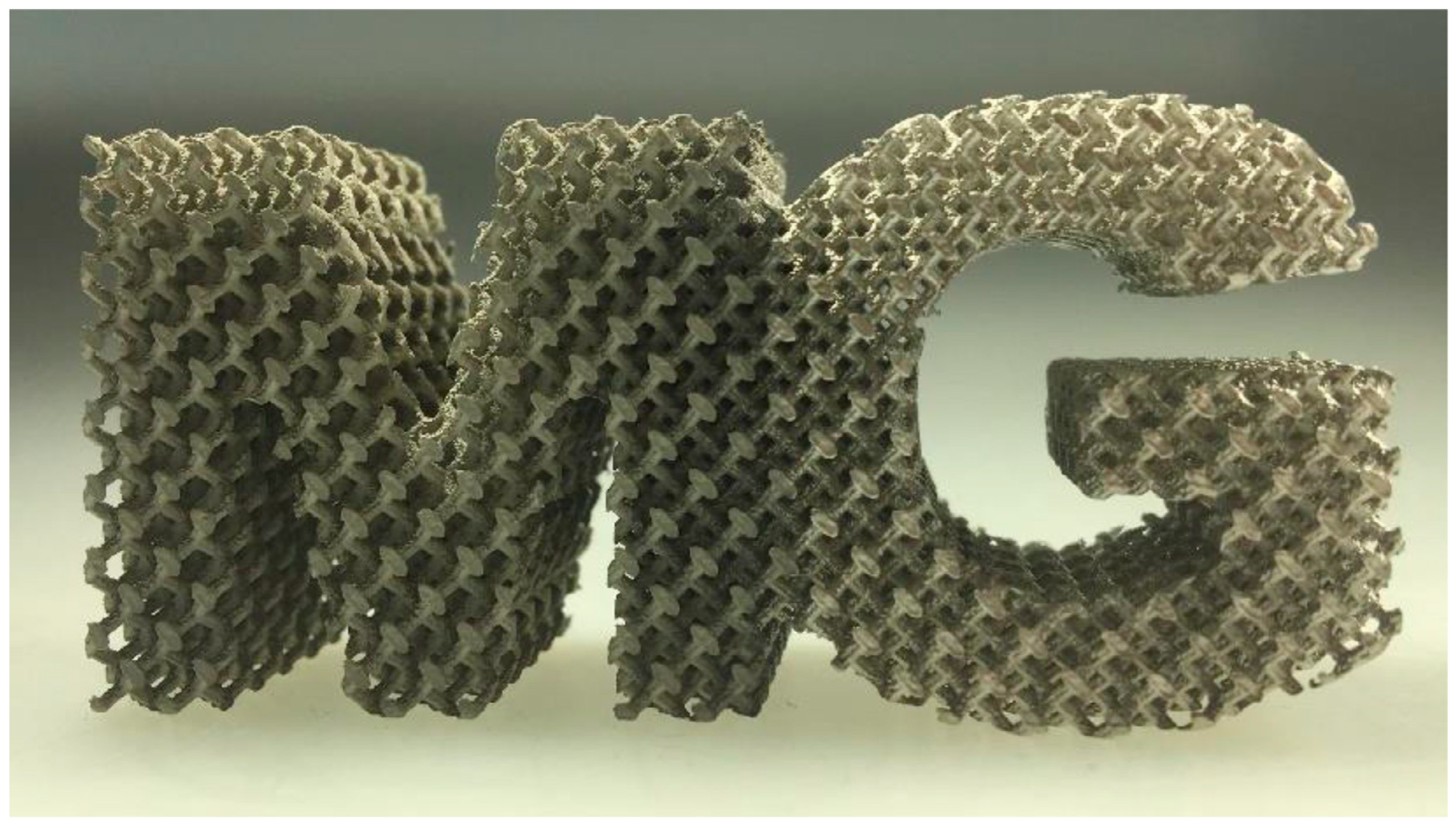
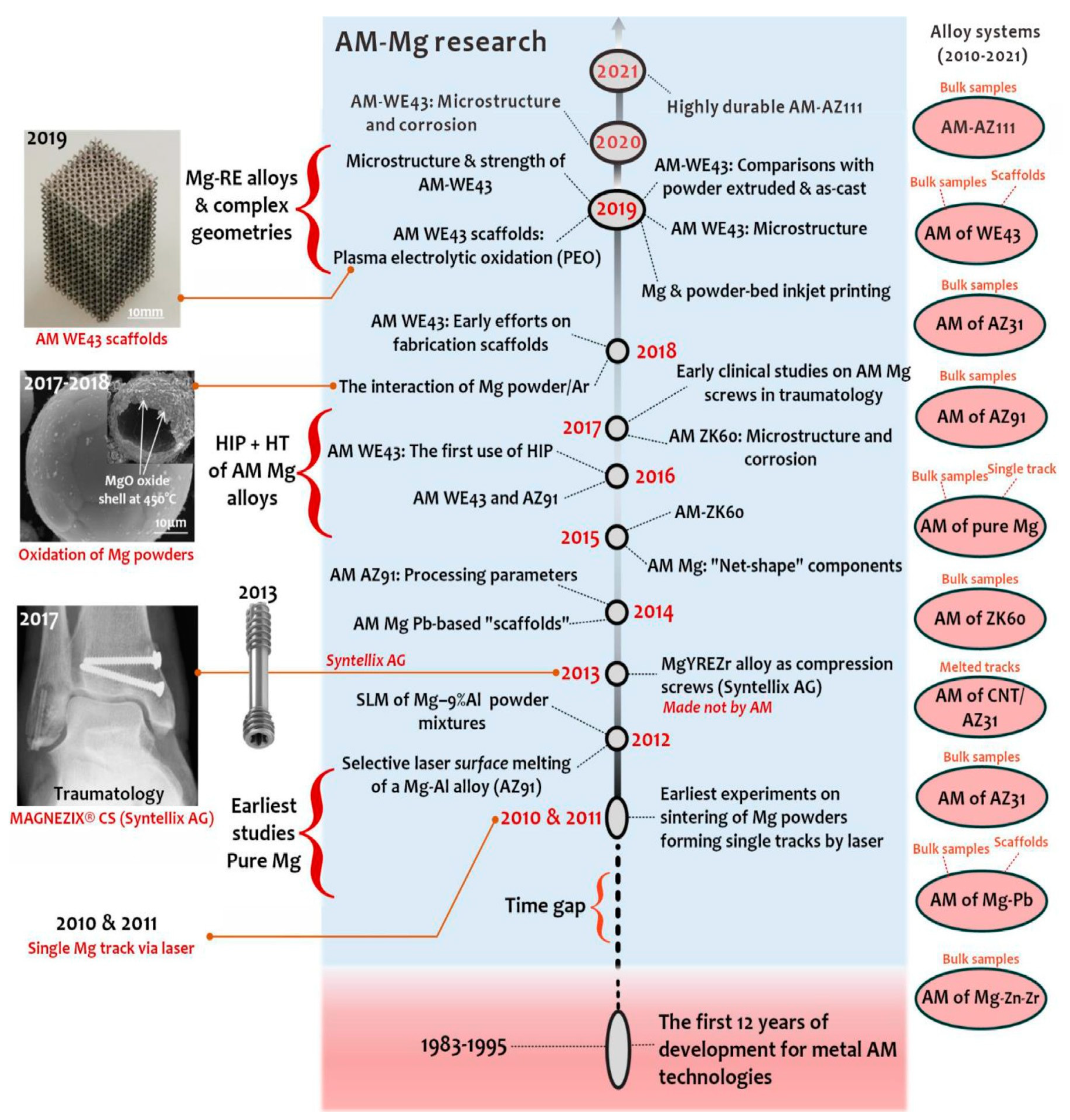
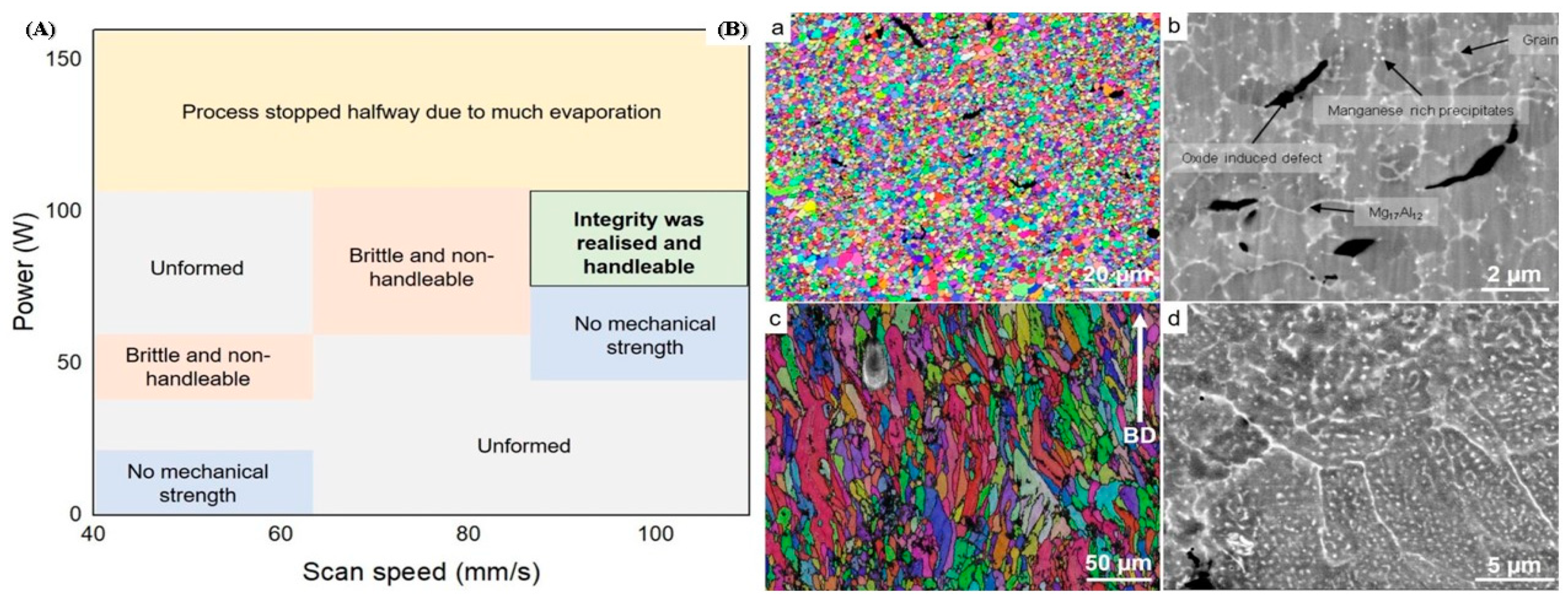
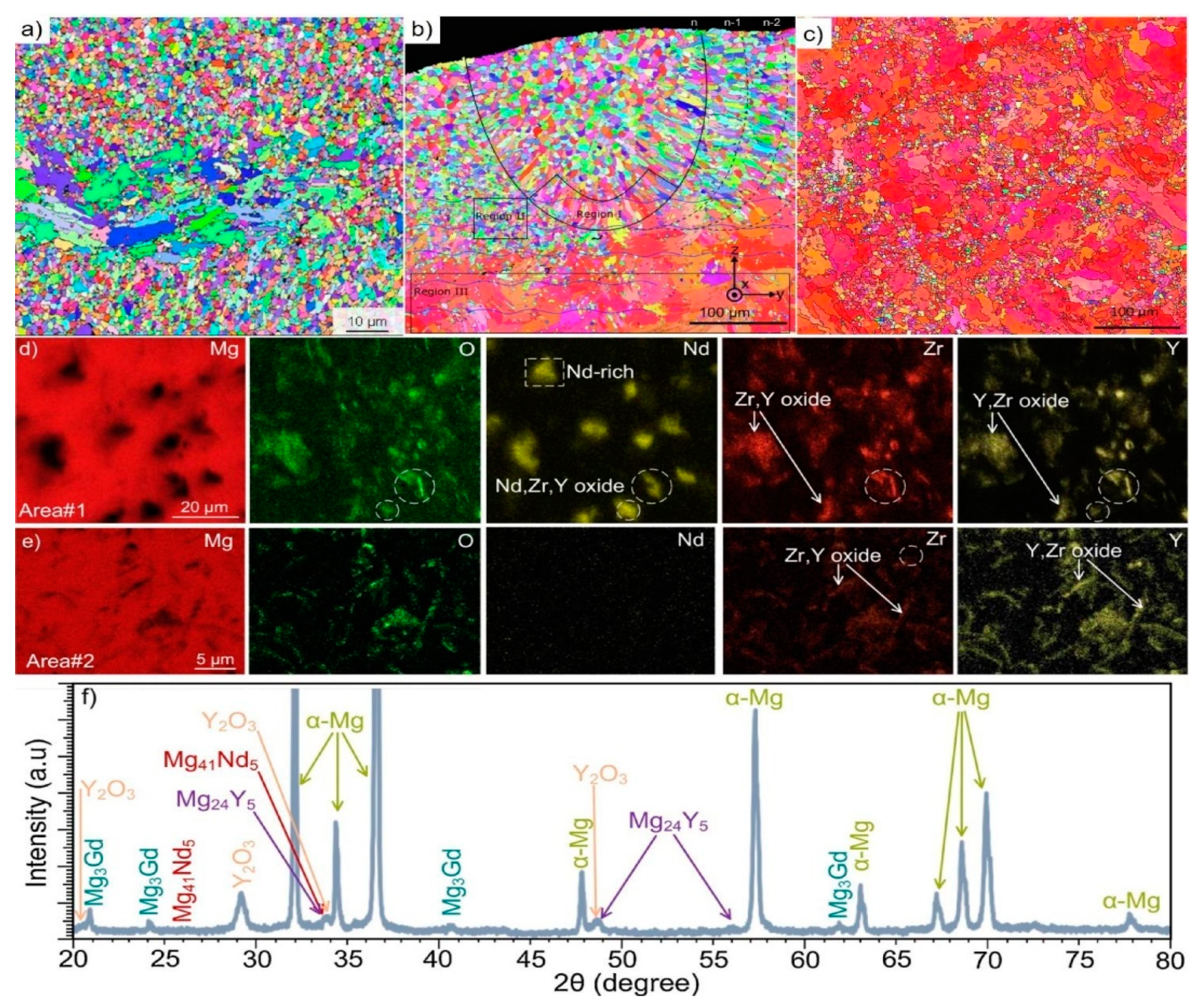
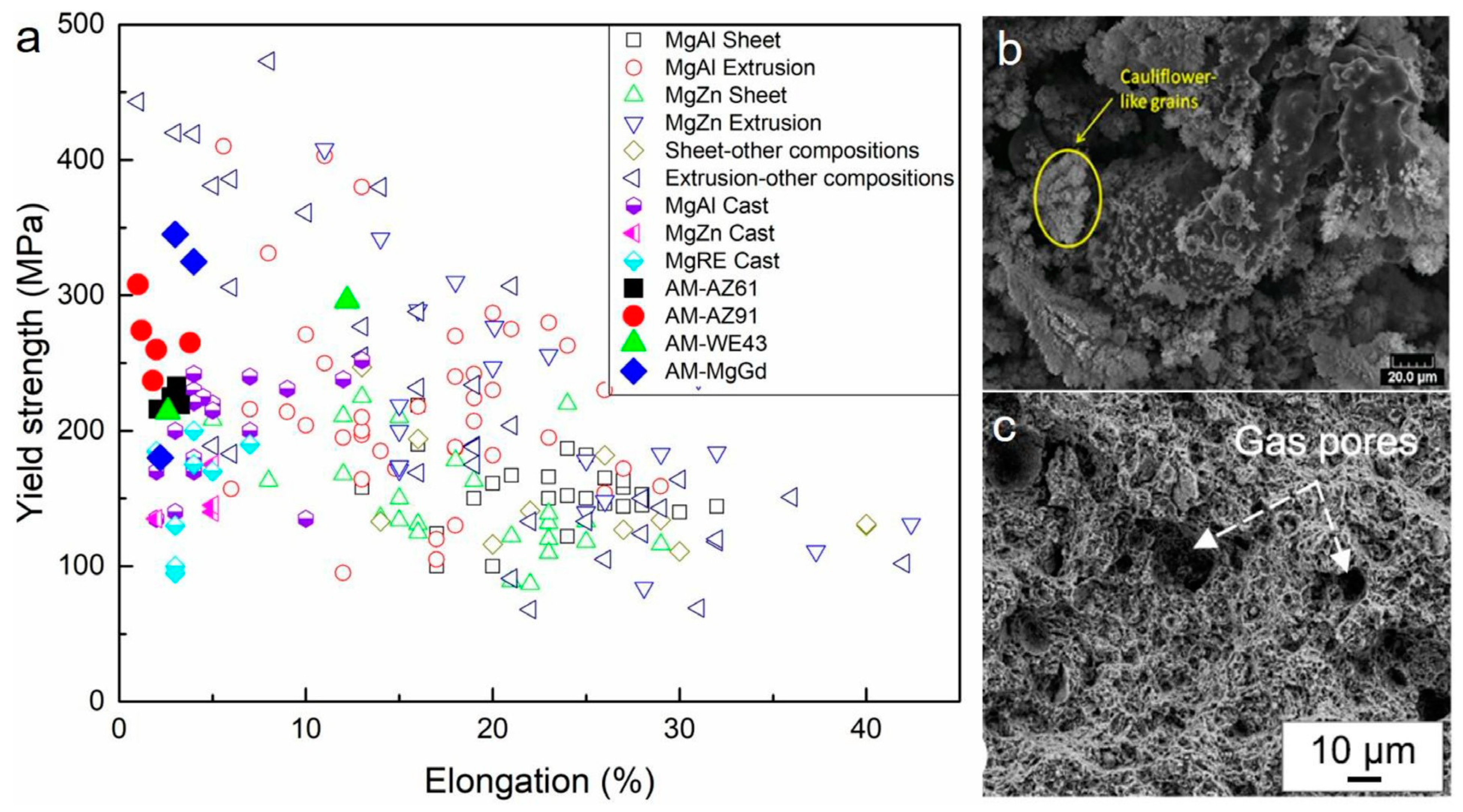
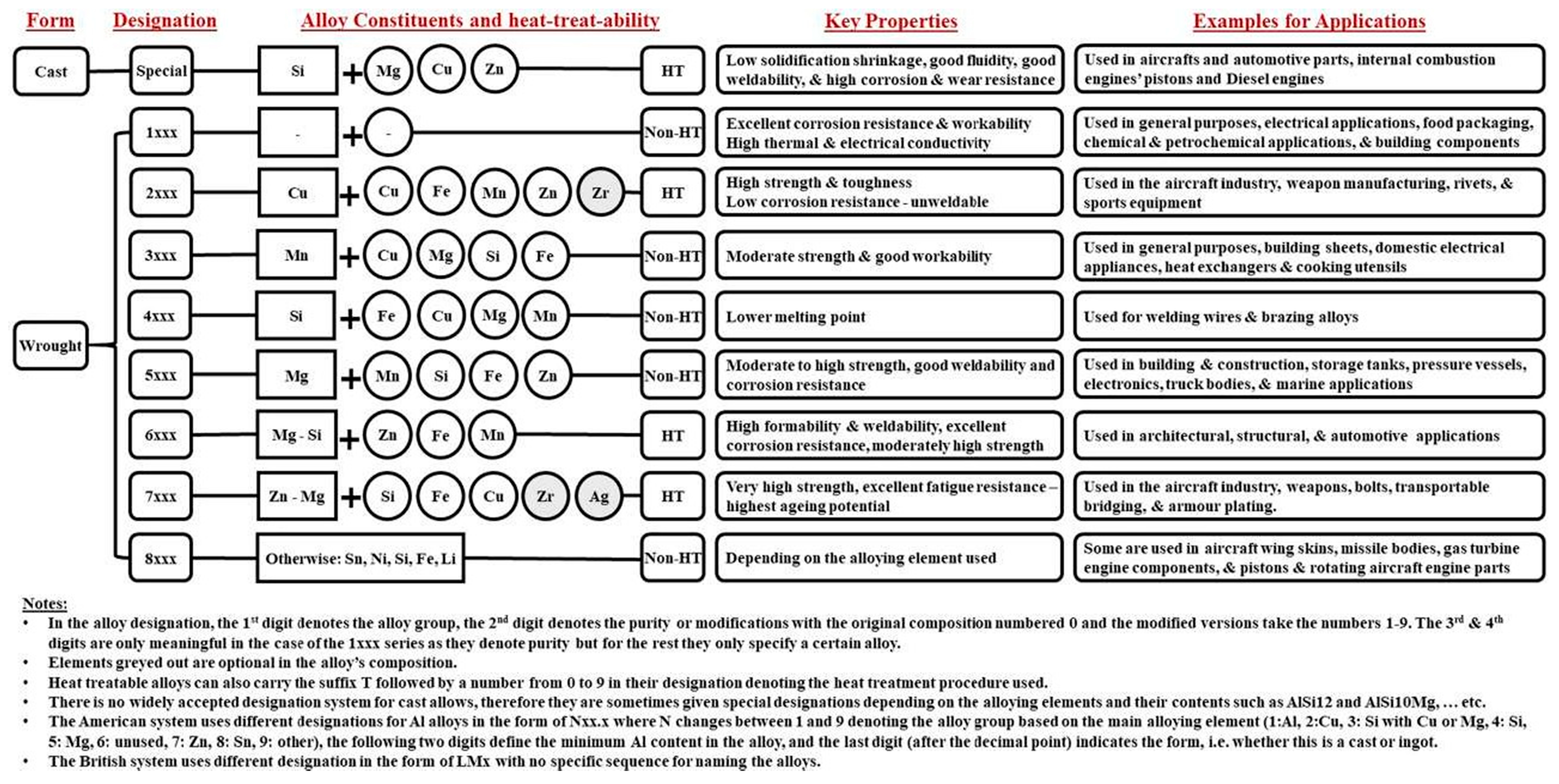
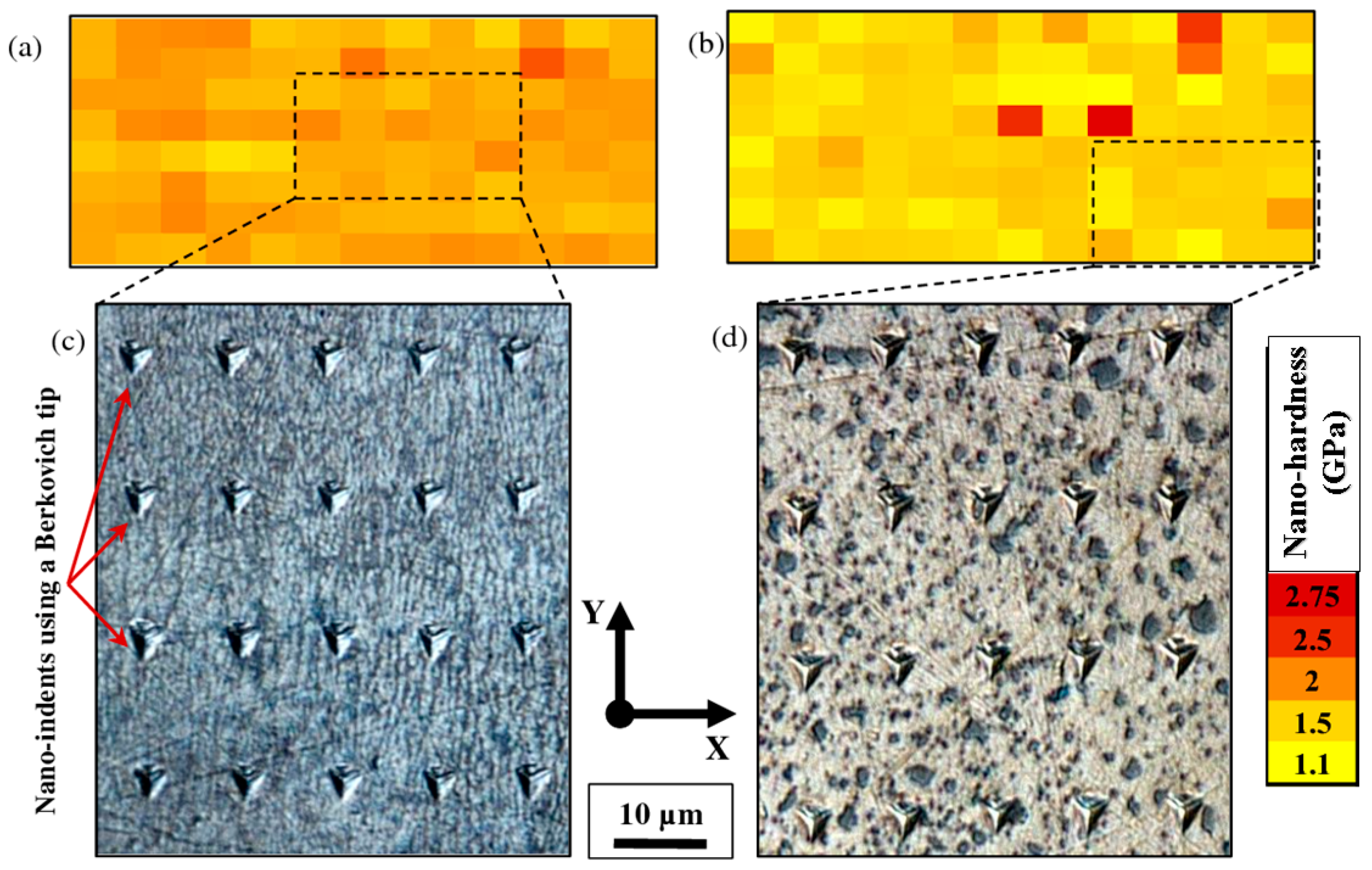
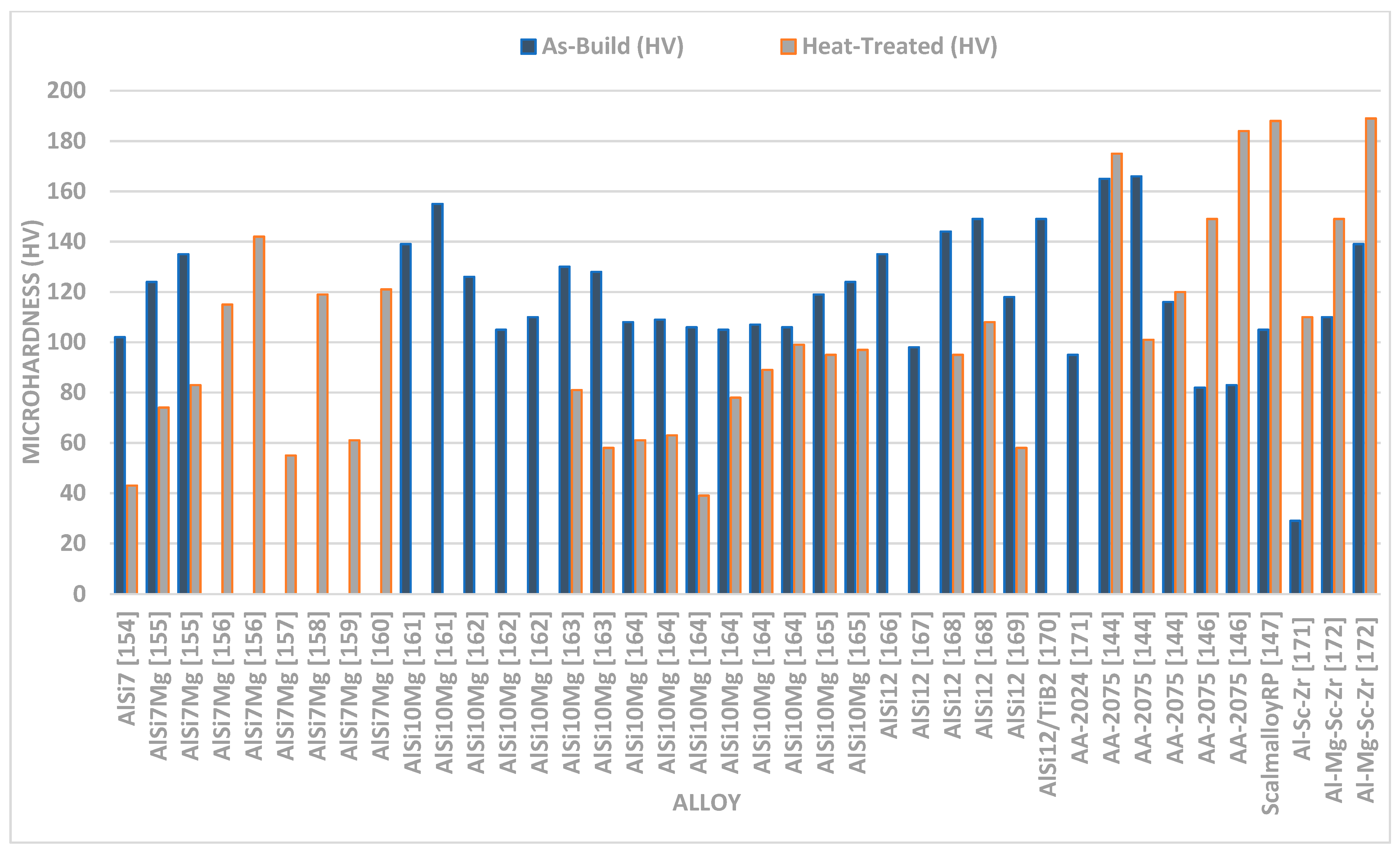

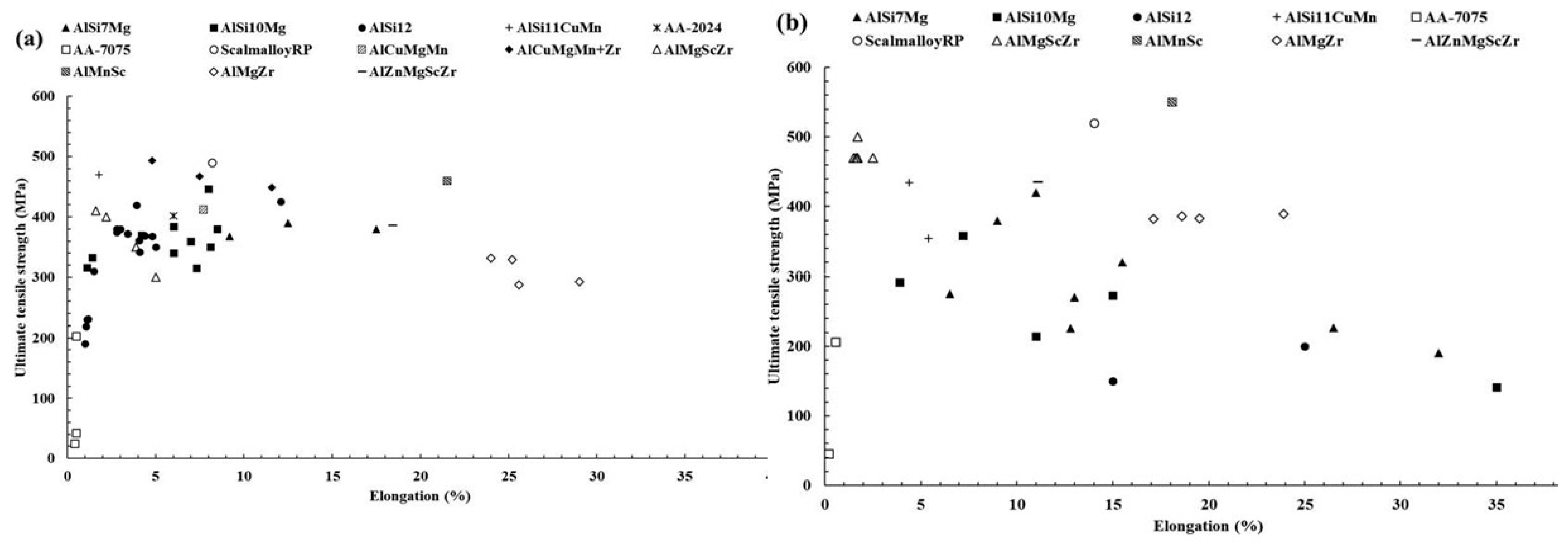


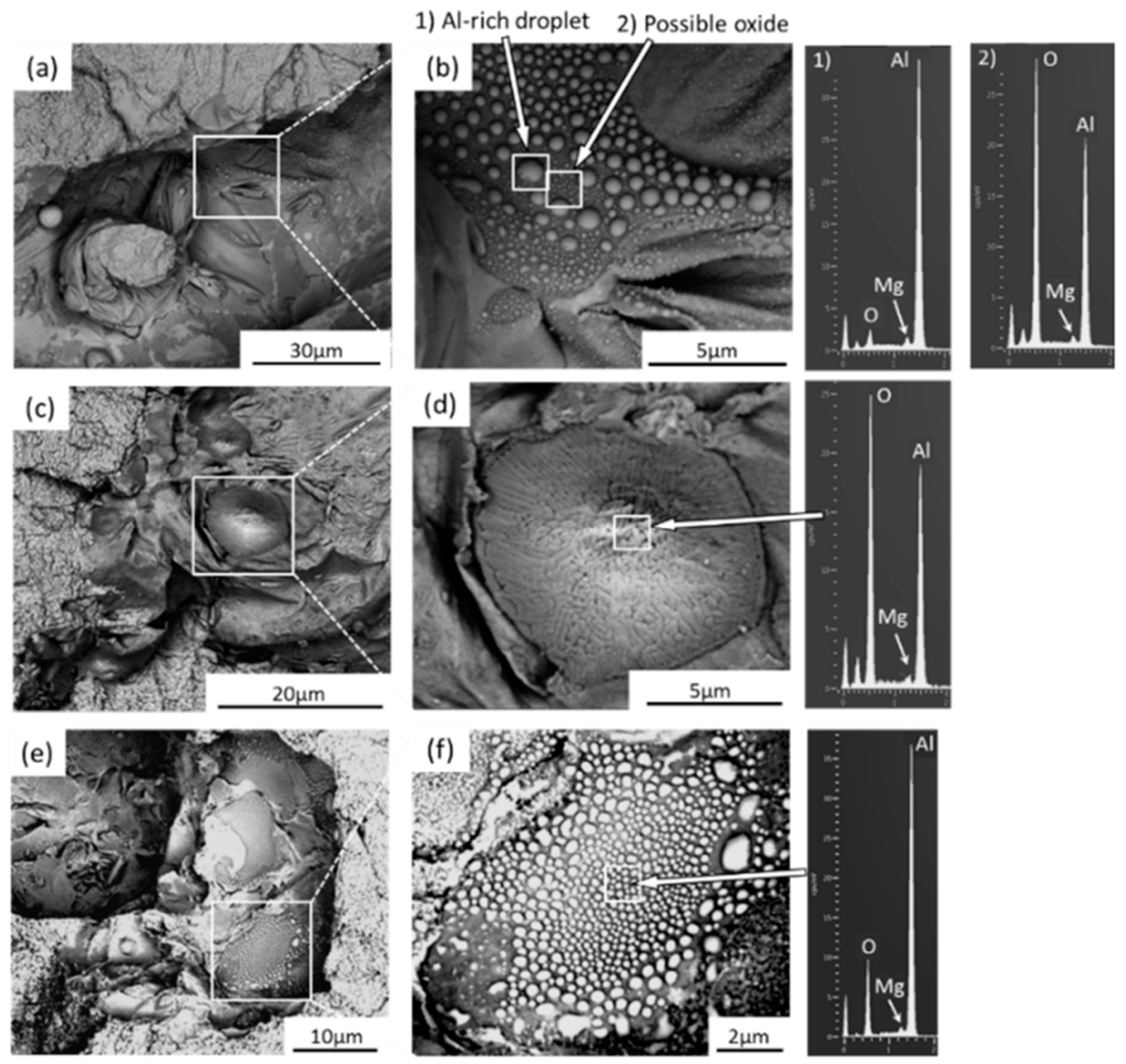

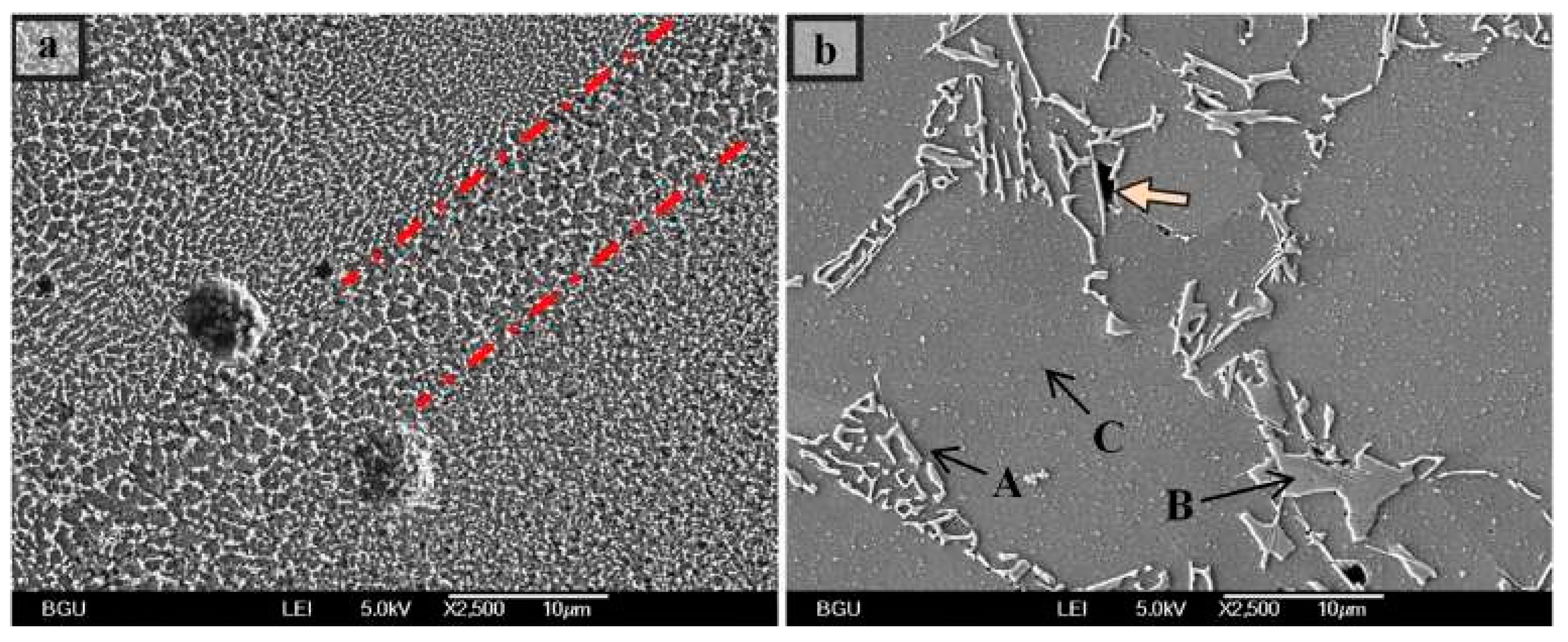

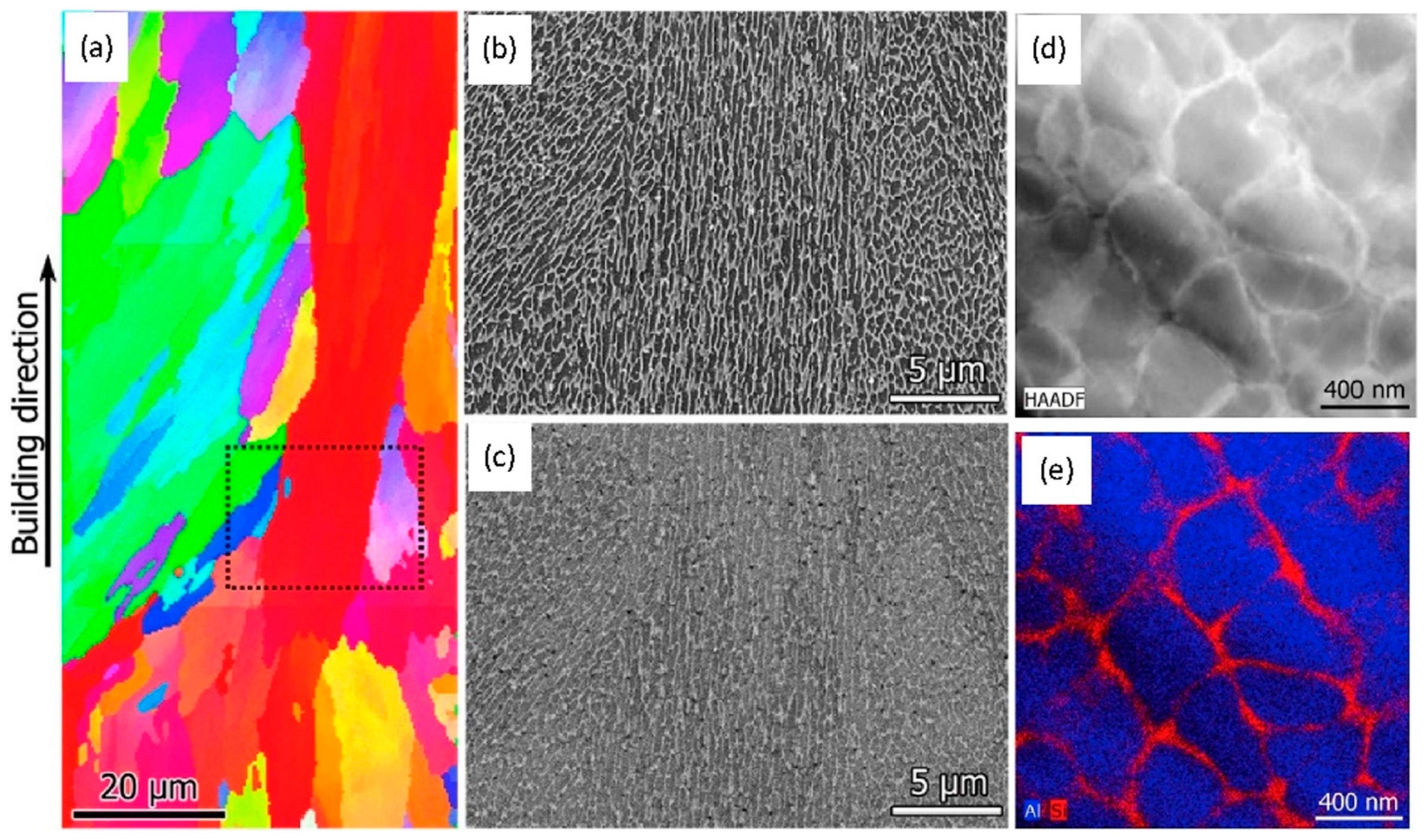
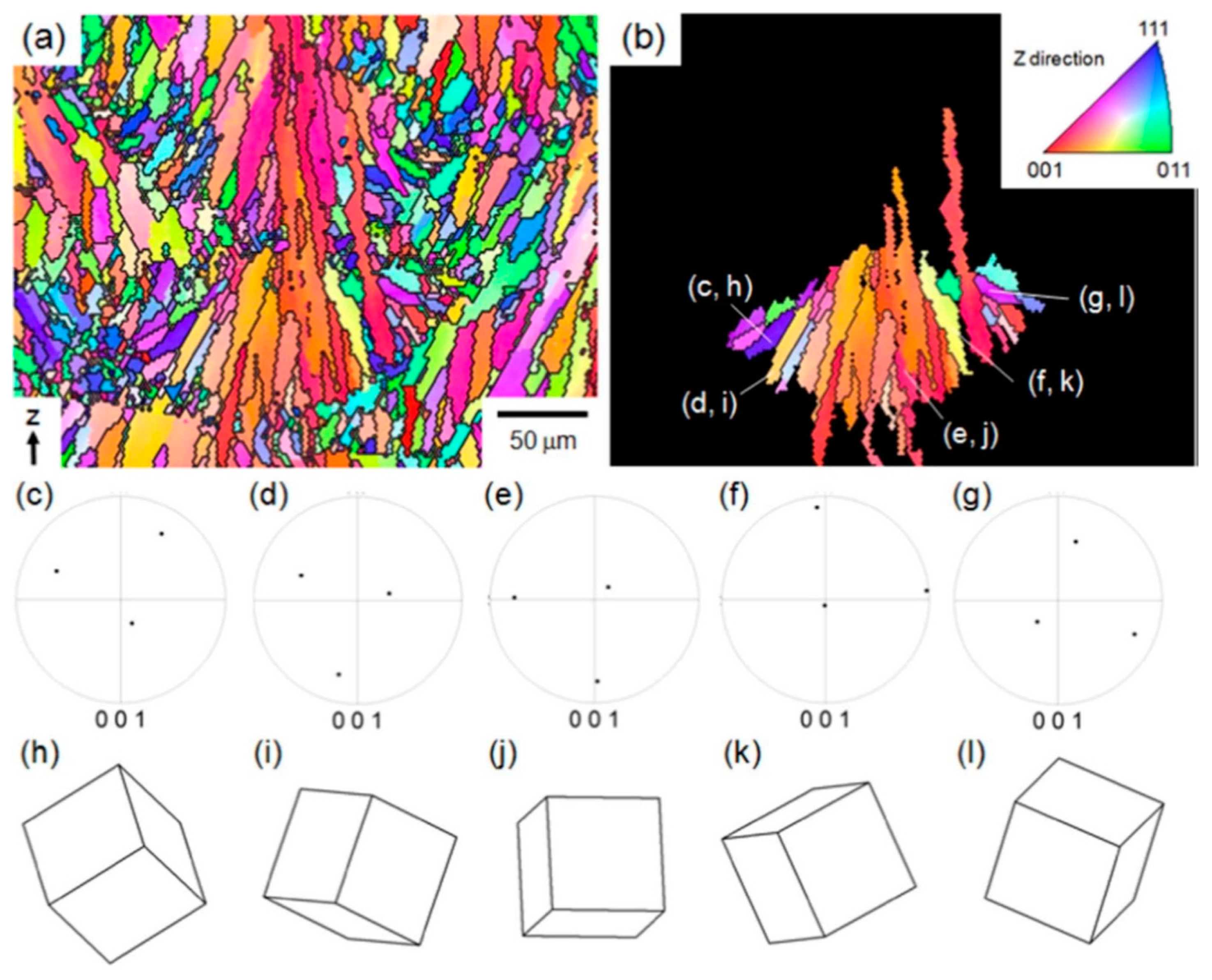
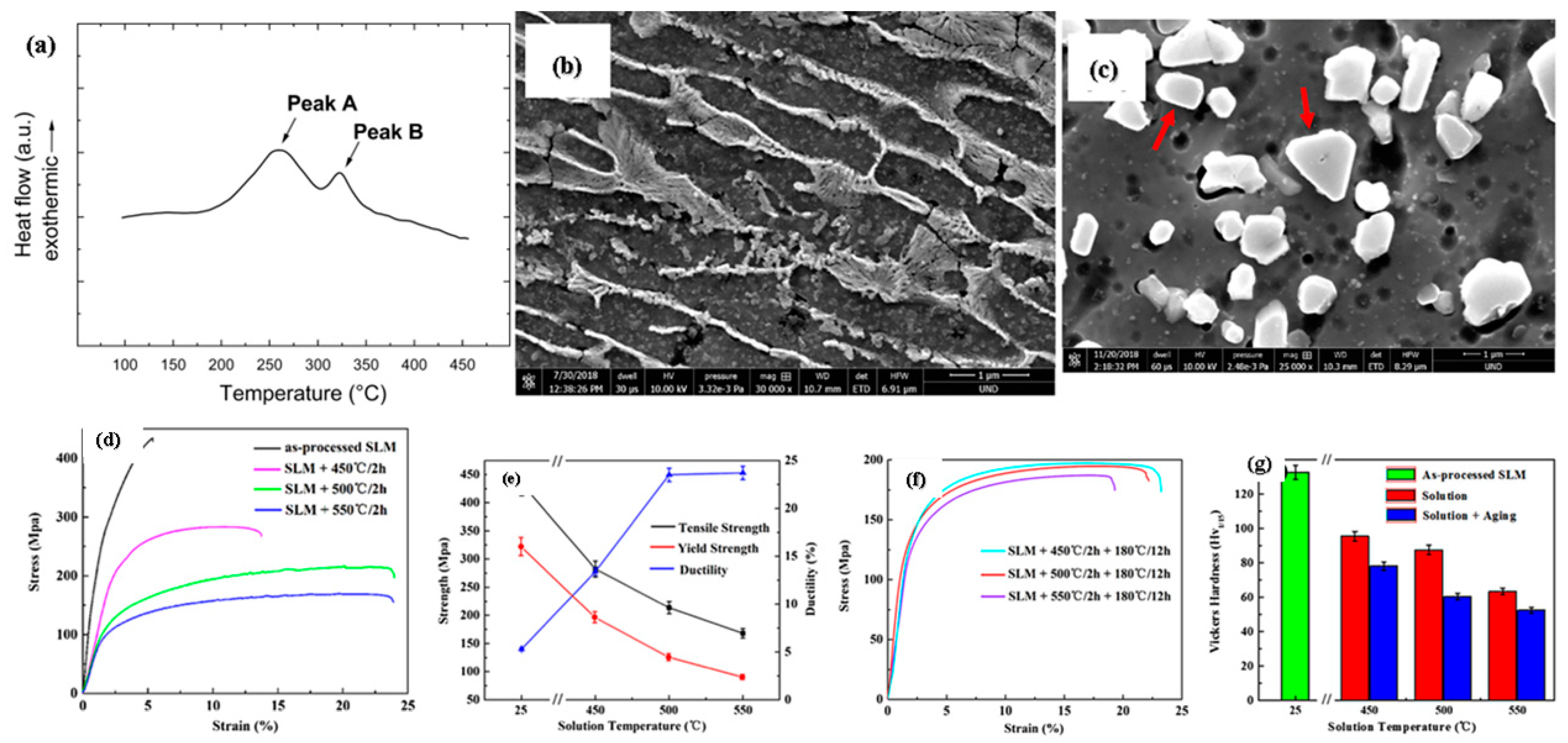
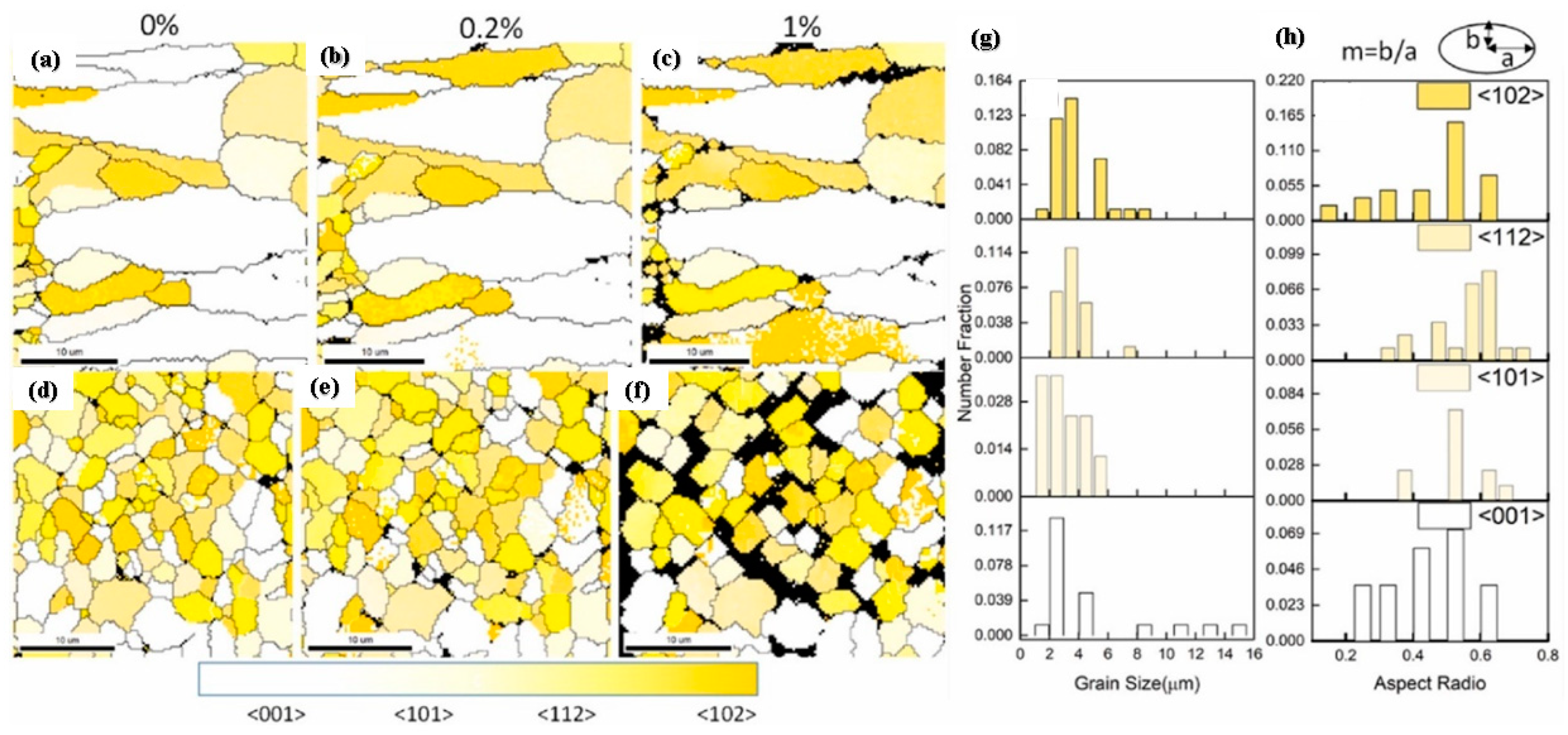
| Alloy Components | Size (μm) and Shape of Powder | Methodology | Parameters Used in Powder-Based Additive Manufacturing Approach | Input Energy Density (J/mm3) | Relative Density (%) | References | ||||
|---|---|---|---|---|---|---|---|---|---|---|
| Power (W) | Spot Size (μm) | Speed (mm/s) | Layer Thickness (μm) | Hatch Spacing (μm) | ||||||
| Mg (Pure) | Pre-alloyed 24 μm, spherical shape | Laser-powder bed fusion | 75 | 85 | 500 | 25 | 35 | 155 | 96.5 | [44] |
| 1240 | 63 | 88.2 | ||||||||
| Mg (Pure) | Pre-alloyed 43 μm, spherical shape | Laser-powder bed fusion | 85 | 90 | 90 | 25 | 90 | 290 | 96 | [45] |
| 85 | 100 | Less than 300 | ||||||||
| Mg-9Al alloy | Blended Mg with size 42 μm, irregular shape, and Al 17 μm, spherical shape | Laser-powder bed fusion | 10 | 30–75 | 10 | 50 | 80 | 250 | 74.5 | [46] |
| 15 | 20 | 187 | 78 | |||||||
| 15 | 40 | 94 | 86.1 | |||||||
| 20 | 40 | 125 | 82 | |||||||
| Mg-9Al alloy | Blended Mg with size 24 μm, spherical shape, and Al 28 μm, spherical shape | Laser-powder bed fusion | 70 | 80 | 500 | 30 | 30 | 156 | 95.7 | [47] |
| 750 | 104 | 88 | ||||||||
| 1000 | 78 | 83 | ||||||||
| 1250 | 63 | 81 | ||||||||
| AZ61 alloy | Pre-alloyed with powder size 48 μm, spherical shape | Laser-powder bed fusion | 145 | 75 | 300 | 45 | 65 | 210 | Less than 99 | [48] |
| 350 | 181 | |||||||||
| 400 | 158 | |||||||||
| 450 | 141 | |||||||||
| 400 | 85 | 157 | 99.1 | |||||||
| 400 | 110 | 95 | 98.1 | |||||||
| AZ61 alloy | Powder size with 70 μm, spherical shape | Laser-powder bed fusion | 65 | 155 | 400 | 55 | 55 | 6000 | 77 | [49] |
| 75 | 7000 | 89 | ||||||||
| 85 | 8000 | 99 | ||||||||
| 95 | 9000 | 95 | ||||||||
| AZ91 alloy | Powder size with 59 μm, spherical shape | Laser-powder bed fusion | 210 | 333 | 45 | 95 | 168 | 99.57 | [50] | |
| AZ91 alloy | Powder size with 53–75 μm, spherical shape | Laser-powder bed fusion | 125 | 85 | 10 | 355 | 510 | 70 | 96.62 | [51] |
| AZ91 alloy | Powder size with 25–63 μm, spherical shape | Laser-powder bed fusion | 110 | 95 | 800 | 35 | 45 | 105 | Less than 99 | [52] |
| AZ91 alloy | Powder size with 30 μm, spherical shape | Laser-powder bed fusion | 45 | – | 200 | 35 | 35 | 279 | 98 | [53] |
| AZ91/SiC composite | Powder size with 50 nm, SiC particles | 98.2 | ||||||||
| WE43 alloy | Powder size with 25 μm, spherical shape | Laser-powder bed fusion | 125 | 95 | 960 | 35 | 45 | 105 | 98.5 | [33] |
| Powder size with 30 μm, spherical shape | 145 | 1200 | 105 | 99.1 | ||||||
| Powder size with 63 μm, spherical shape | 310 | 1200 | 209 | 99.4 | ||||||
| WE43 alloy | Powder size with 25–63 μm, spherical shape | Laser-powder bed fusion | 205 | 95 | 700 | 35 | 45 | 239 | 99.78 | [54] |
| WE43 alloy | Powder size with 25–63 μm, spherical shape | Laser-powder bed fusion | 205 | 75 | 1100 | 45 | 135 | 38 | 99.6 | [55] |
| WE43 alloy | Powder size with 25–63 μm, spherical shape | Laser-powder bed fusion | 205 | 130 | 700 | 35 | 45 | 239 | 99.89 | [56] |
| WE43 alloy | Powder size with 25–63 μm, spherical shape | Laser-powder bed fusion | 200 | 110 | 800 | 35 | 210 | 42 | 99.75 | [57] |
| 200 | 800 | 245 | 35 | 98.4 | ||||||
| 200 | 1200 | 210 | 29 | 96.6 | ||||||
| 200 | 1200 | 210 | 20 | 87.7 | ||||||
| G10K alloy | Powder size with 63 μm, spherical shape | Laser-powder bed fusion | 85 | – | 200 | 35 | 90 | 135 | 99.3 | [58] |
| GZ112K alloy | Powder size with 31–44 μm, spherical shape | Laser-powder bed fusion | 85 | 110 | 100 | 35 | 90 | 268 | 98.9 | [59] |
| 300 | 90 | 99.8 | ||||||||
| 500 | 54 | 99.4 | ||||||||
| 700 | 39 | 99.5 | ||||||||
| 1000 | 28 | 96.4 | ||||||||
| 1500 | 19 | 71.9 | ||||||||
| 500 | 45 | 106 | 99.4 | |||||||
| 500 | 145 | 37 | 96.4 | |||||||
| GZ151K alloy | Powder size with 25–65 μm, spherical shape | Laser-powder bed fusion | 210 | – | 700 | 35 | 75 | 138 | 98 | [60] |
| Mg-1Zn alloy | Blended Mg-5.5Zn with Powder size of 36 μm involving Mg powder size 31 μm and Zn powder size 19 μm; spherical shape | Laser-powder bed fusion | 185 | 140 | 700 | 25 | 75 | 184 | 99.1 | [61] |
| Mg-2Zn alloy | 98.5 | |||||||||
| Mg-6Zn alloy | 94.9 | |||||||||
| Mg-12Zn alloy | 99 | |||||||||
| ZK60 alloy | Powder size with 30 μm, spherical shape | Laser-powder bed fusion | 210 | 140 | 300 | 25 | 85 | 418 | 95 | [62] |
| 500 | 255 | 94 | ||||||||
| 700 | 180 | 89 | ||||||||
| 900 | 140 | 85 | ||||||||
| Alloy | Input Energy Density (J/mm3) | Grain Size (μm) | Micro-Hardness (HV) | Yield Strength (MPa) | Ultimate Tensile Strength (MPa) | Elongation. (%) | Electrochemical Solution | Icorr (μA/cm2) | Mass Loss mm/Year | References |
|---|---|---|---|---|---|---|---|---|---|---|
| Mg (Pure) | 97–88 | 1–5 | – | – | – | – | Hank’s solution | 75–180 | 5–33 | [44] |
| Mg (Pure) | 295 | – | 52.4 | – | – | – | – | – | – | [45] |
| Mg-9Al | 251 | 15–25 | 71 | – | – | – | – | – | [46] | |
| Mg-9Al | 150 | 1.5–3.5 | – | 274 | 1.1 | – | – | – | [47] | |
| AZ61 | 140 | 1.5 | – | 220 | 275 | 3.5 | – | – | – | [48] |
| 155 | 1.7 | 235 | 285 | 3.0 | ||||||
| 180 | 2.0 | 220 | 260 | 2.9 | ||||||
| 205 | 2.4 | 214 | 240 | 2.2 | ||||||
| AZ61 | 125 | 4.5 | 71 | – | – | – | Simulated body fluid solution | 2.8 | [49] | |
| 145 | 9 | 81 | 2.5 | |||||||
| 161 | 10 | 94 | 1.3 | |||||||
| 181 | 12 | 91 | 1.6 | |||||||
| AZ91 | 165–85 | 1.5–3 | 86–105 | 27 | 296 | 1.2 | [50] | |||
| 83 | 2.9 | 237 | 254 | 1.8 | ||||||
| AZ91 | 68 | 1–11 | 114 | – | – | – | [51] | |||
| AZ91 | 103 | 1–2 | – | 270 | 330 | 3.9 | [52] | |||
| AZ91 | 280 | 3.5 | – | 310 | 350 | 1.1 | – | – | – | [53] |
| AZ91-SiC | 280 | 1.2 | – | 265 | 310 | 2.1 | – | – | – | |
| AZ91–2Ca | – | – | – | 240 | 335 | 3.3 | – | – | – | [27] |
| WE43 | 125 | 35 | – | – | – | – | NaCl (0.1 M) | 5.1 | 6.1 | [27] |
| 150 | 28 | 5.0 | – | |||||||
| 300 | 19 | 4.6 | ||||||||
| WE43 | 240 | 1.5 | – | 300 | 310 | 12.1 | – | – | – | [54] |
| WE43 | 40 | 1–4 | – | 215 | 255 | 2.8 | – | – | – | [55] |
| WE43 | 240 | 20.5 | – | – | – | – | – | – | – | [56] |
| WE43 | [57] | |||||||||
| G10K | 135 | 28 | 81 | 187 | 230 | 2.3 | – | – | – | [58] |
| GZ112K | 90 | 1.8 | – | 330 | 335 | 4.2 | – | – | – | [59] |
| GZ151K | 140 | 2.1 | 350 | 370 | 3.2 | – | – | – | [60] | |
| Mg-1Zn | 185 | – | 52 | 150 | 11.1 | – | – | – | [61] | |
| Mg-2Zn | 45 | 75 | 2.4 | |||||||
| Mg-6Zn | 66 | 55 | 1.4 | |||||||
| Mg-12Zn | 84 | 80 | 3.3 | |||||||
| ZK30 | 2000 | – | 81 | – | – | – | Simulated body fluid solution | 17.8 | 1.20 | [27] |
| ZK30-Cu | 99 | 47.8 | 2.25 | |||||||
| Pure Mg | – | – | – | – | – | – | NaCl (3 wt.%) | 999 | 144 | [27] |
| S.No | Aluminum Alloys | Condition of Heat Treatment | Yield Strength (MPa) | Ultimate Tensile Strength (MPa) | Elongation (%) | References |
|---|---|---|---|---|---|---|
| 1 | AlSi10Mg | (i) As-built (ii) 540 °C–1 h,180 °C–2 h | (i) 264 (ii) 277 | (i) 451 (ii) 331 | (i) 8 and 6 (ii) 5 and 8 | [237] |
| 2 | AlSi10Mg | (i) As-built (ii) 550 °C–1 h,180 °C–2 h | (i) 225 (ii) 270 | (i) 429 (ii) 321 | (i) 4 (ii) 9 | [242] |
| 3 | AlSi7Mg | (i) As-built (ii) 540 °C–1 h,160 °C–4 h | (i) 257 (ii) 256 | (i) 398 (ii) 306 | (i) 7 and 6 (ii) 4 and 7 | [243] |
| 4 | AlSi10Mg | (i) As-built (ii) 540 °C–1 h,180 °C–8 h | (i) 275 (ii) 236 | (i) 406 (ii) 288 | (i) 3 and 8 (ii) 9 and 3 | [241] |
| 5 | AlSi10Mg | (i) As built (ii) 535 °C–1 h,190 °C–10 h | (i) 270 (ii) 164 | (i) 446 (ii) 214 | (i) 8 and 1 (ii) 11 | [244] |
| 6 | AlSi10Mg | (i) As built (ii) 540 °C–1 h,160 °C–6 h | (i) 360 (ii) 290 | (i) 307 (ii) 267 | (i) 1 and 7 (ii) 2 and 5 | [245] |
| 7 | AlSi7Mg | (i) As-built (ii) 160 °C–8 h | (i) 225 (ii) 280 | (i) 375 (ii) 400 | (i) 7 and 5 (ii) 5 and 5 | [246] |
| 8 | AlSi10Mg | (i) As-built (ii) 200 °C–2 h | (i) 263 (ii) 298 | (i) 473 (ii) 479 | (i) 7 and 8 (ii) 5 and 6 | [247] |
| 9 | AlSi10Mg | (i) As-built (ii) 175 °C–1 h | (i) 267 (ii) 310 | (i) 391 (ii) 440 | (i) 5 and 6 (ii) 4 and 4 | [248] |
| 10 | AlSi10Mg | (i) As-built (ii) 160 °C–5 h | (i) 255 (ii) 268 | (i) 377 (ii) 342 | (i) 2 and 2 (ii) 0 and 9 | [249] |
| 11 | AlSi10Mg | (i) As-built (ii) 160 °C–4 h | (i) 257 (ii) 309 | (i) 398 (ii) 411 | (i) 7 and 6 (ii) 4 and 8 | [250] |
Publisher’s Note: MDPI stays neutral with regard to jurisdictional claims in published maps and institutional affiliations. |
© 2022 by the authors. Licensee MDPI, Basel, Switzerland. This article is an open access article distributed under the terms and conditions of the Creative Commons Attribution (CC BY) license (https://creativecommons.org/licenses/by/4.0/).
Share and Cite
Sharma, S.K.; Grewal, H.S.; Saxena, K.K.; Mohammed, K.A.; Prakash, C.; Davim, J.P.; Buddhi, D.; Raju, R.; Mohan, D.G.; Tomków, J. Advancements in the Additive Manufacturing of Magnesium and Aluminum Alloys through Laser-Based Approach. Materials 2022, 15, 8122. https://doi.org/10.3390/ma15228122
Sharma SK, Grewal HS, Saxena KK, Mohammed KA, Prakash C, Davim JP, Buddhi D, Raju R, Mohan DG, Tomków J. Advancements in the Additive Manufacturing of Magnesium and Aluminum Alloys through Laser-Based Approach. Materials. 2022; 15(22):8122. https://doi.org/10.3390/ma15228122
Chicago/Turabian StyleSharma, Sachin Kumar, Harpreet Singh Grewal, Kuldeep Kumar Saxena, Kahtan A. Mohammed, Chander Prakash, J. Paulo Davim, Dharam Buddhi, Ramesh Raju, Dhanesh G. Mohan, and Jacek Tomków. 2022. "Advancements in the Additive Manufacturing of Magnesium and Aluminum Alloys through Laser-Based Approach" Materials 15, no. 22: 8122. https://doi.org/10.3390/ma15228122
APA StyleSharma, S. K., Grewal, H. S., Saxena, K. K., Mohammed, K. A., Prakash, C., Davim, J. P., Buddhi, D., Raju, R., Mohan, D. G., & Tomków, J. (2022). Advancements in the Additive Manufacturing of Magnesium and Aluminum Alloys through Laser-Based Approach. Materials, 15(22), 8122. https://doi.org/10.3390/ma15228122










